< Prev Index Next >
 Chess by Isaac Kashdan Sun, Dec 12, 1971 – 122 · The Los Angeles Times (Los Angeles, California) · Newspapers.com
Chess by Isaac Kashdan Sun, Dec 12, 1971 – 122 · The Los Angeles Times (Los Angeles, California) · Newspapers.com
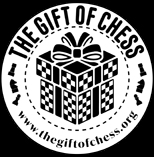
Notice to commercial publishers seeking use of images from this collection of chess-related archive blogs. For use of the many large color restorations, two conditions must be met: 1) It is YOUR responsibility to obtain written permissions for use from the current holders of rights over the original b/w photo. Then, 2) make a tax-deductible donation to The Gift of Chess in honor of Robert J. Fischer-Newspaper Archives. A donation in the amount of $250 USD or greater is requested for images above 2000 pixels and other special request items. For small images, such as for fair use on personal blogs, all credits must remain intact and a donation is still requested but negotiable. Please direct any photographs for restoration and special request (for best results, scanned and submitted at their highest possible resolution), including any additional questions to S. Mooney, at bobbynewspaperblogs•gmail. As highlighted in the ABC News feature, chess has numerous benefits for individuals, including enhancing critical thinking and problem-solving skills, improving concentration and memory, and promoting social interaction and community building. Initiatives like The Gift of Chess have the potential to bring these benefits to a wider audience, particularly in areas where access to educational and recreational resources is limited.
| Best of Chess |
Fischer Newspaper Archives
• Robert J. Fischer, 1955
 • Robert J. Fischer, 1956  • Robert J. Fischer, 1957  • Robert J. Fischer, 1958  • Robert J. Fischer, 1959  • Robert J. Fischer, 1960  • Robert J. Fischer, 1961  • Robert J. Fischer, 1962  • Robert J. Fischer, 1963  • Robert J. Fischer, 1964  • Robert J. Fischer, 1965  • Robert J. Fischer, 1966  • Robert J. Fischer, 1967  • Robert J. Fischer, 1968  • Robert J. Fischer, 1969  • Robert J. Fischer, 1970  • Robert J. Fischer, 1971  • Robert J. Fischer, 1972  • Robert J. Fischer, 1973  • Robert J. Fischer, 1974  • Robert J. Fischer, 1975  • Robert J. Fischer, 1976  • Robert J. Fischer, 1977  • Robert J. Fischer, 1978  • Robert J. Fischer, 1979  • Robert J. Fischer, 1980  • Robert J. Fischer, 1981  • Robert J. Fischer, 1982  • Robert J. Fischer, 1983  • Robert J. Fischer, 1984  • Robert J. Fischer, 1985  • Robert J. Fischer, 1986  • Robert J. Fischer, 1987  • Robert J. Fischer, 1988  • Robert J. Fischer, 1989  • Robert J. Fischer, 1990  • Robert J. Fischer, 1991  • Robert J. Fischer, 1992  • Robert J. Fischer, 1993  • Robert J. Fischer, 1994  • Robert J. Fischer, 1995  • Robert J. Fischer, 1996  • Robert J. Fischer, 1997  • Robert J. Fischer, 1998  • Robert J. Fischer, 1999  • Robert J. Fischer, 2000  • Robert J. Fischer, 2001  • Robert J. Fischer, 2002  • Robert J. Fischer, 2003  • Robert J. Fischer, 2004  • Robert J. Fischer, 2005  • Robert J. Fischer, 2006  • Robert J. Fischer, 2007  • Robert J. Fischer, 2008  |
Chess Columns |
Additional Archives/Social Media
• Bobby Fischer, 1955-2008
• Newspaper Chess Games Archive • Best of Chess History • Chess Column + Notes • Centuries of Chess • Chess Notation Conversion • Sideline Studies • Chess Hall of Shame |
< Prev Index Next >
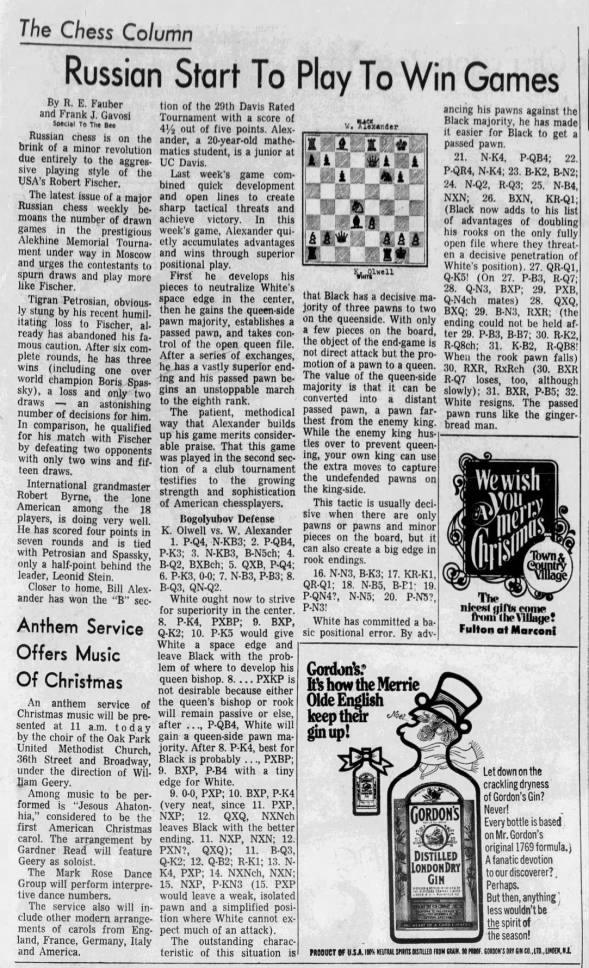 The Chess Column Sun, Dec 12, 1971 – 29 · The Sacramento Bee (Sacramento, California) · Newspapers.com
The Chess Column Sun, Dec 12, 1971 – 29 · The Sacramento Bee (Sacramento, California) · Newspapers.com
The Chess Column: Russian Start To Play To Win Games by R.E. Fauber and Frank J. Garosi
Russian chess is on the brink of a minor revolution due entirely to the aggressive playing style of the USA's Robert Fischer.
The latest issue of a major Russian chess weekly bemoans the number of drawn games in the prestigious Alekhine Memorial Tournament under way in Moscow and urges the contestants to spurn draws and play more like Fischer.
Tigran Petrosian, obviously stung by his recent humiliating loss to Fischer, already has abandoned his famous caution. After six complete rounds, he has three wins (including one over world champion Boris Spassky), a loss and only two draws — an astonishing number of decisions for him. In comparison, he qualified for his match with Fischer by defeating two opponents with only two wins and fifteen draws.
International grandmaster Robert Byrne, the lone American among the 18 players, is doing very well. He has scored four points in seven rounds and is tied with Petrosian and Spassky, only a half-point behind the leader, Leonid Stein.
< Prev Index Next >
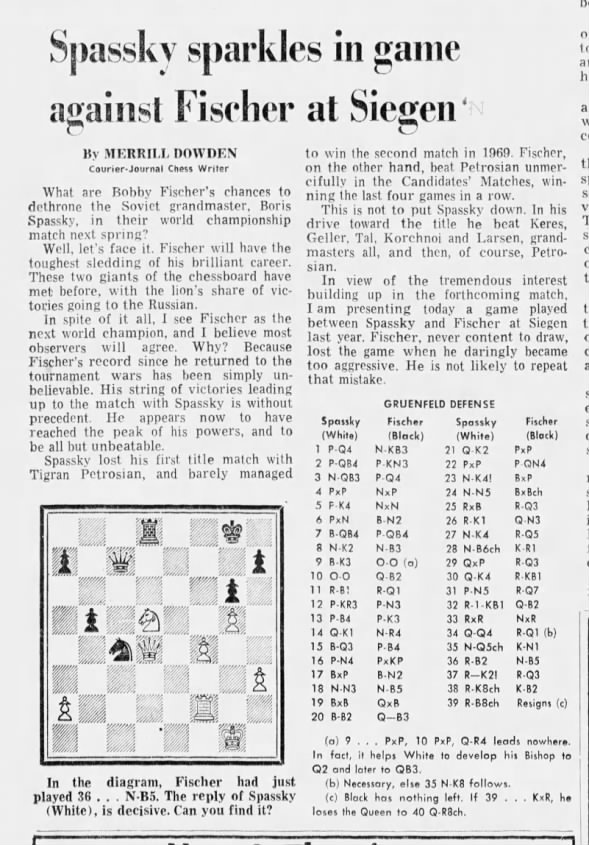 The King's Men Sun, Dec 12, 1971 – Page 66 · The Courier-Journal (Louisville, Kentucky) · Newspapers.com
The King's Men Sun, Dec 12, 1971 – Page 66 · The Courier-Journal (Louisville, Kentucky) · Newspapers.com
The King's Men: Spassky Sparkles in Game Against Fischer at Siegen by Merrill Dowden
What are Bobby Fischer's chances to dethrone the Soviet grandmaster, Boris Spassky, in their world championship match next spring?
Well, let's face it. Fischer will have the toughest sledding of his brilliant career. These two giants of the chessboard have met before, with the lion's share of victories going to the Russian.
In spite of it all, I see Fischer as the next world champion, and I believe most observers will agree. Why? Because Fischer's record since he returned to the tournament wars has been simply unbelievable. His string of victories leading up to the match with Spassky is without precedent. He appears now to have reached the peak of his powers, and to be all but unbeatable.
Spassky lost his first title match with Tigran Petrosian, and barely managed to win the second match in 1969. Fischer, on the other hand, beat Petrosian unmercifully in the Candidates' Matches, winning the last four games in a row.
This is not to put Spassky down. In his drive toward the title he beat Keres, Geller, Tal, Korchnoi and Larsen, grandmasters all, and then, of course, Petrosian.
In view of the tremendous interest building up in the forthcoming match, I am presenting today a game played between Spassky and Fischer at Siegen last year. Fischer, never content to draw, lost the game when he daringly became too aggressive. He is not likely to repeat that mistake.
Boris Spassky vs Robert James Fischer Siegen ol (Men) fin-A (1970), Siegen FRG, rd 6, Sep-20 Gruenfeld Defense: Exchange. Classical Variation (D86) 1-0 https://www.chessgames.com/perl/chessgame?gid=1044698
1. d4 Nf6 2. c4 g6 3. Nc3 d5 4. cxd5 Nxd5 5. e4 Nxc3 6. bxc3 Bg7 7. Bc4 c5 8. Ne2 Nc6 9. Be3 O-O(a) 10. O-O Qc7 11. Rc1 Rd8 12. h3 b6 13. f4 e6 14. Qe1 Na5 15. Bd3 f5 16. g4 fxe4 17. Bxe4 Bb7 18. Ng3 Nc4 19. Bxb7 Qxb7 20. Bf2 Qc6 21. Qe2 cxd4 22. cxd4 b5 23. Ne4 Bxd4 24. Ng5 Bxf2+ 25. Rxf2 Rd6 26. Re1 Qb6 27. Ne4 Rd4 28. Nf6+ Kh8 29. Qxe6 Rd6 30. Qe4 Rf8 31. g5 Rd2 32. Rf1 Qc7 33. Rxd2 Nxd2 34. Qd4 Rd8(b) 35. Nd5+ Kg8 36. Rf2 Nc4 37. Re2 Rd6 38. Re8+ Kf7 39. Rf8+ 1-0(c)
(a) 9 … PxP, 10. PxP Q-R4 leads nowhere. In fact, it helps White to develop his Bishop to Q2 and later to Q-B3.
(b) Necessary, else 35. N-K8 follows.
(c) Black has nothing left. If 39. … KxR, he loses the Queen to 40. Q-R8ch.
< Prev Index Next >
 Chess Fri, Dec 10, 1971 – 31 · Deseret News (Salt Lake City, Utah) · Newspapers.com
Chess Fri, Dec 10, 1971 – 31 · Deseret News (Salt Lake City, Utah) · Newspapers.com
Chess by Harold Lundstrom Friday, December 10, 1971 Deseret News Salt Lake City, Utah Deseret News Problem 977. White...
Posted by Bobby Fischer's True History on Sunday, November 29, 2020
Deseret News Problem 977. White to move and mate in two.
FEN 4nQ2/K6B/pN2pP1R/r2Nk3/3bn3/6Pp/1B2b3/4Rr1q w - - 0 1
Key: 1. N-N4
Books Tell Of Fischer's Chess Play by Harold Lundstrom
With the phenomenal recent successes of Robert (Bobby) Fischer, now the official challenger of the world chess championship, all books by him or about him are in demand.
An example is “Fischer 1970,” a booklet prepared by Isaac Kashdan which contains all the 73 match and tournament games he played last year. The first edition has been sold out, and it has now been reprinted by the U.S. Chess Federation.
Fischer was awarded the “Chess Oscar” for 1970 as player of the year. He scored 80 percent against top competition, one of the best records ever compiled in grandmaster chess.
Included in the 25 pages of the book are comments on each game, tables, and introductions to each event and a general summary of Fischer's activities. The printing is offset from original typed copy. The price is $1.75.
Other books in this series, also by Mr. Kashdan, chess editor of the Los Angeles Times, contain all the games of the Buenos Aires Tournament and the Amsterdam Tournament of 1970.
Buenos Aires was one of Fischer's greatest triumphs, in which he finished points ahead of the field. There are 153 games in 36 pages, selling for $3.
The Amsterdam Tournament, sponsored by the IBM Corporation, resulted in a tie between world champion, Boris Spassky, USSR and his compatriot, Lev Polo Polugaevsky. It has 120 games in 24 pages, and is price at $1.75.
Anyone wishing autobiographed copies of one or more of these books can send his check to Isaac Kashdan, Chess Editor, Los Angeles Times …
< Prev Index Next >
 Chess Mon, Dec 6, 1971 – 21 · The Guardian (London, Greater London, England) · Newspapers.com
Chess Mon, Dec 6, 1971 – 21 · The Guardian (London, Greater London, England) · Newspapers.com
Chess: Books for Presents by Leonard Barden
The approach of Christmas is a good opportunity to suggest some possibilities for suitable chess gifts. Keen players in general and tournament and postal regulars in particular are likely to be best satisfied by a recently published book […]
Many enthusiasts who are new to chess in 1971 will have been attracted by the publicity for Fischer's bid for the world championship. Call him the George Best, the Nicklaus, or the Mohammed Ali of chess—and they all fit—he has become only the third chess name (following Morphy and Capablanca) whose career is widely followed by the non-chess playing public. My 60 Memorable Games, by Bobby Fischer (Faber, £3) is Fischer's career in his own words, with a style akin to his play—terse but very much to the point. With the world title match due to start next spring, there may be other books about Fischer (and his Russian opponent Spassky appearing at that time.)
< Prev Index Next >
 Chess Sun, Dec 5, 1971 – 226 · The Boston Globe (Boston, Massachusetts) · Newspapers.com
Chess Sun, Dec 5, 1971 – 226 · The Boston Globe (Boston, Massachusetts) · Newspapers.com
Chess: The question: Why did he flinch? by Harold Dondis
A look back at the Petrosian-Fischer match shows that the Russians set a diabolical trap for Fischer in pre-game analysis which was all but snapped shut in the first game.
Fischer had used the opening as White to win two games against Taimanov.
The first game started as follows:
Robert James Fischer vs Tigran Vartanovich Petrosian Fischer - Petrosian Candidates Final (1971), Buenos Aires ARG, rd 1, Sep-30 Sicilian Defense: Paulsen. Szen Variation (B44)1-0 https://www.chessgames.com/perl/chessgame?gid=1044350
1. P-K4 P-QB4 1. e4 c5 2. N-KB3 P-K 2. Nf3 e6 3. P-Q4 PxP 3. d4 cxd4 4. NxP N-QB3 4. Nxd4 Nc6 5. N-N5 P-Q3 5. Nb5 d6 6. B-KB4 P-K4 6. Bf4 e5 7. B-K3 N-KB3 7. Be3 Nf6 8. B-N5 B-K3 8. Bg5 Be6 9. QN-B3 P-QR3 9. N1c3 a6 10. BxN PxB 10. Bxf6 gxf6 11. N-R3 11. Na3
Here, Taimanov had played 13. … Q-R4. But Suetin, who has been working closely with Petrosian for two years, harbored a new move since 1962 and he worked on it with Petrosian and probably Bondarevsky and others in preparation for Bobby. 13. … P-Q4!
Now if 14. NxP BxN(5) 15. PxB BxN(3) etc. So Bobby thought 20 minutes and played PxP BxN; 13. NPxB Q-R4; 14. Q-Q2 O-O-O; 15. B-B4 (Harry Lyman says QR-Q is best), R-KN 16. R-Q (O-O loses to B-R6), B-B4?
Like the battle of Leyte Gulf in which the Japanese fleet withdrew with American troops transports at its mercy, Petrosian did not move in for the kill.
Post-game analyses in Boston by Lyman, Ozols and Robertie, give Petrosian a clear win with 16. … RxP. Korchnoi and Furman have since come to the same conclusion.
The lines as published in “Chess” are: 17. Q-K3 N-Q5; 18. K-B1 NxP; 19. Q-Q3 R-N5 (att'g. the B). On 17. N-K4 R-N3; 18. QxQ NxQ; 19. PxB NxB; 20. PxP R-B1; 21. R-Q5 P-N3.
Bobby held on desperately, finally equalized and then won as Petrosian ran out of time. A win by Petrosian in the 1st game, put with his actual 2nd round win might have broken Fischer's spirit. Why did the Russians fail to look one move deeper? Why did Petrosian flinch? Does Fischer have an answer somewhere? Why did Petrosian fail to play the line again? Time alone will supply the answers.
< Prev Index Next >
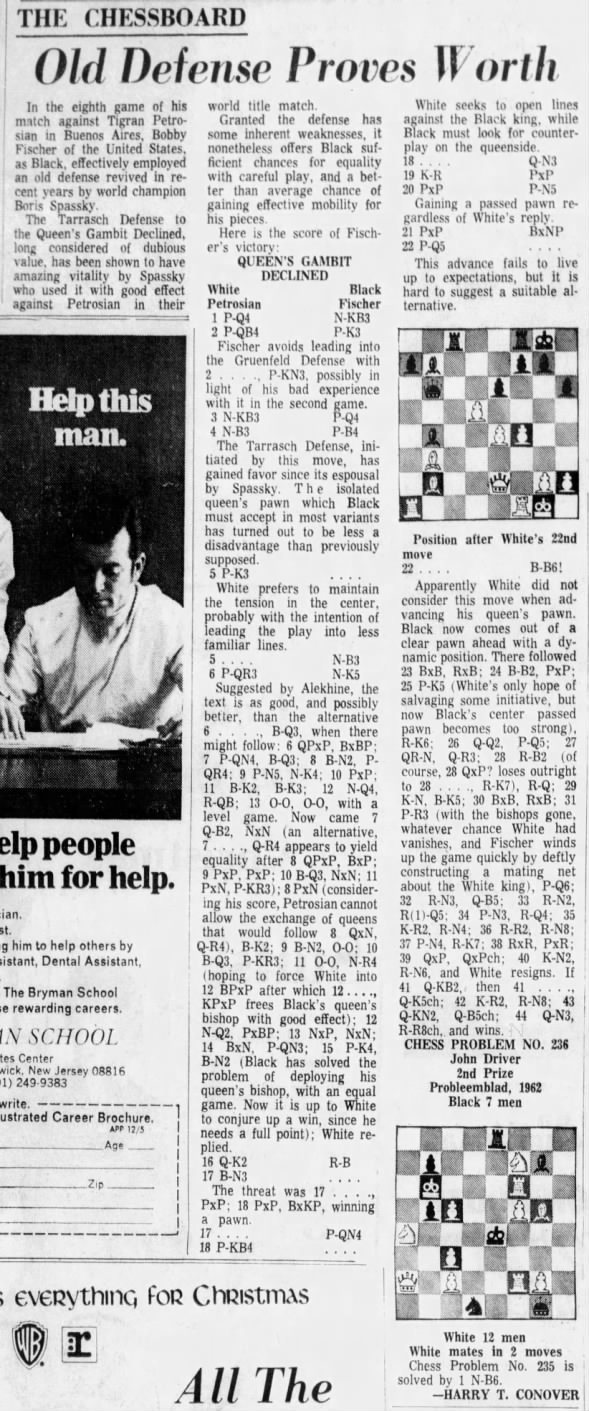 The Chessboard Sun, Dec 5, 1971 – Page 44 · Asbury Park Press (Asbury Park, New Jersey) · Newspapers.com
The Chessboard Sun, Dec 5, 1971 – Page 44 · Asbury Park Press (Asbury Park, New Jersey) · Newspapers.com
The Chessboard by Harry T. Conover Sunday, December 05, 1971 Asbury Park Press Asbury Park, New Jersey Chess Problem...
Posted by Bobby Fischer's True History on Friday, November 27, 2020
Chess Problem No. 236 by John Driver, 2nd Prize, Probleemblad, 1962. White mates in 2 moves.
FEN 4r3/1p3Nb1/1K3R2/1pP2PB1/N3k3/2P5/Q1P2RP1/3n2q1 w - - 0 1
Key: R-Q2/Rd2
The Chessboard: Old Defense Proves Worth by Harry T. Conover
In the eighth game of his match against Tigran Petrosian in Buenos Aires, Bobby Fischer of the United States, as Black, effectively employed an old defense revived in recent years by world champion Boris Spassky.
The Tarrasch Defense to the Queen's Gambit Declined, long considered of dubious value, has been shown to have amazing vitality by Spassky who used it with good effect against Petrosian in their world title match.
Granted the defense has some inherent weaknesses, it nonetheless offers Black sufficient chances for equality with careful play, and a better than average chance of gaining effective mobility for his pieces.
Here is the score of Fischer's victory:
Tigran Vartanovich Petrosian vs Robert James Fischer Fischer - Petrosian Candidates Final (1971), Buenos Aires ARG, rd 8, Oct-23 Tarrasch Defense: Symmetrical Variation (D32) 0-1 https://www.chessgames.com/perl/chessgame?gid=1044717
1. d4 Nf6
2. c4 e6
Fischer avoids leading into the Gruenfeld Defense with 2. … P-KN3, possibly in light of his bad experience with it in the second game.
3. Nf3 d5
4. Nc3 c5
The Tarrasch Defense, initiated by this move, has gained favor since its espousal by Spassky. The isolated queen's pawn which Black must accept in move variants has turned out to be less a disadvantage than previously supposed.
5. e3 …
White prefers to maintain the tension in the center, probably with the intention of leading the play into less familiar lines.
5. … Nc6
6. a3 Ne4
Suggested by Alekhine, the text is as good, and possibly better, than the alternative 6. … B-Q3, when there might follow: 6 QPxP BxBP; 7. P-QN4 B-Q3; 8. B-N2 P-QR4; 9. P-N5 N-K4; 10. PxP 11. B-K2 B-K3; 12. N-Q4 R-QB; 13. O-O O-O with a level game.
Now came 7. Qc2 Nxc3 (an alternative, 7. … Q-R4 appears to yield equality after 8. QPxP BxP; 9. PxP PxP; 10. B-Q3 NxN; 11. PxN P-KR3)
8. bxc3 (considering his score, Petrosian cannot allow the exchange of queens that would follow 8. QxN Q-R4) …
8. … Be7
9. Bb2 O-O
10. Bd3 h6
11. O-O Na5 (hoping to force White into 12. BPxP after which 12. … KPxP frees Black's queen's bishop with good effect)
12. Nd2 dxc4
13. Nxc4 Nxc4
14. Bxc4 b6
15. e4 Bb7
(Black has solved the problem of deploying his queen's bishop, with an equal game. Now it is up to White to conjure up a win, since he needs a full point)
White replied.
16. Qe2 Rc8
17. Bb3 …
The threat was 17. … PxP; 18. PxP BxKP, winning a pawn.
17. … b5
18. f4 …
White seeks to open lines against the Black king, while Black must look for counterplay on the queenside.
18. … Qb6
19. Kh1 cxd4
20. cxd4 b4
Gaining a passed pawn regardless of White's reply.
21. axb4 Bxb4
22. d5 …
This advance fails to live up to expectations, but it is hard to suggest a suitable alternative.
22. … Bc3!
Apparently White did not consider this move when advancing his queen's pawn. Black now comes out of a clear pawn ahead with a dynamic position. There followed:
23. Bxc3 Rxc3
24. Bc2 exd5
25. e5 …
White's only hope of salvaging some initiative, but now Black's center passed pawn becomes too strong
25. … Re3
26. Qd2 d4
27. Rab1 Qa6
28. Rf2 …
of course, 28. QxP? loses outright to 28. … R-K7
28. … Rd8
29. Kg1 Be4
30. Bxe4 Rxe4
31. h3 …
With the bishops gone, whatever chance White had vanishes, and Fischer winds up the game quickly by deftly constructing a mating net about the White king
31. … d3
32. Rb3 Qc4
33. Rb2 Rdd4
34. g3 Rd5
35. Kh2 Rb5
36. Ra2 Rb1
37. g4 Re2
38. Rxe2 dxe2
39. Qxe2 Qxf4+
40. Kg2 Rb3 and White resigns.
If 41. Q-KB2, then 41. … Q-K5ch; 42. K-R2 R-N8; 43. Q-KN2 Q-B5ch; 44. Q-N3 R-R8ch and wins.
< Prev Index Next >
 Chess Sun, Dec 5, 1971 – 15 · The Bangor Daily News (Bangor, Maine) · Newspapers.com
Chess Sun, Dec 5, 1971 – 15 · The Bangor Daily News (Bangor, Maine) · Newspapers.com
Chess by George Cunningham and Gerry Dullea Sunday, December 05, 1971 The Bangor Daily News Bangor,...
Posted by Bobby Fischer's True History on Friday, November 27, 2020
Problem
Clearly, Black should lose. The problem is to mate him without wasting moves. Can you find the mate in two moves? White to move.
FEN 3k4/8/4K3/8/8/8/8/4R3 w - - 0 1
Key: 1. R-QB1 K-K1 (forced); 2. R-B8 mate.
(i.e., 1. Rc1 Ke8 2. Rc8#)
< Prev Index Next >
 Chess Master Sat, Dec 4, 1971 – 23 · Times Colonist (Victoria, British Columbia, Canada) · Newspapers.com
Chess Master Sat, Dec 4, 1971 – 23 · Times Colonist (Victoria, British Columbia, Canada) · Newspapers.com
Chess Master by George Koltanowski Saturday, December 04, 1971 Times Colonist Victoria, British Columbia,...
Posted by Bobby Fischer's True History on Friday, November 27, 2020
Problem by Edouard Barthelemy, France. White to play and mate in two moves.
FEN 8/KN3Q2/1pkN1pr1/6q1/P3p1p1/2B4n/8/2R4b w - - 0 1
Key: N-K8/Ne8
A Bad Start
Petrosian did not fare quite so well in the first game of the Candidates' Finals in Buenos Aires. There his role and that of Bobby Fischer appeared reversed. Fischer playing solid chess and Petrosian attacking chess.
Robert James Fischer vs Tigran Vartanovich Petrosian Fischer - Petrosian Candidates Final (1971), Buenos Aires ARG, rd 1, Sep-30 Sicilian Defense: Paulsen. Szen Variation (B44) 1-0 https://www.chessgames.com/perl/chessgame?gid=1044350
1. e4 c5 2. Nf3 e6 3. d4 cxd4 4. Nxd4 Nc6 5. Nb5 d6 6. Bf4 e5 7. Be3 Nf6 8. Bg5 Be6(a) 9. N1c3 a6 10. Bxf6 gxf6(b) 11. Na3 d5(c) 12. exd5(d) Bxa3 13. bxa3 Qa5 14. Qd2 O-O-O 15. Bc4 Rhg8 16. Rd1 Bf5 17. Bd3 Bxd3 18. Qxd3 Nd4 19. O-O Kb8 20. Kh1 Qxa3 21. f4 Rc8 22. Ne4 Qxd3 23. cxd3 Rc2 24. Rd2 Rxd2 25. Nxd2 f5 26. fxe5 Re8 27. Re1 Nc2 28. Re2 Nd4 29. Re3 Nc2 30. Rh3 Rxe5 31. Nf3 Rxd5 32. Rxh7 Rxd3 33. h4 Ne3 34. Rxf7 Rd1+ 35. Kh2 Ra1 36. h5 f4 37. Rxf4 Rxa2 38. Re4 Nxg2 39. Kg3 Ra5 40. Ne5 1-0(e)
(a) Something different. In the first Fischer-Taimanov match, Black played 8 … Q-R4ch.
(b) Cannot play 10. … QxB, as 11. N-B7ch follows.
(c) Petrosian makes a pawn sacrifice in the opening …!
(d) Fischer took close to half an hour on this move.
(e) Black's game has blown a fuse … Not only does he lose his Knight, but to stop White's Rook's pawn from queening will cost him the Rook as well.
< Prev Index Next >
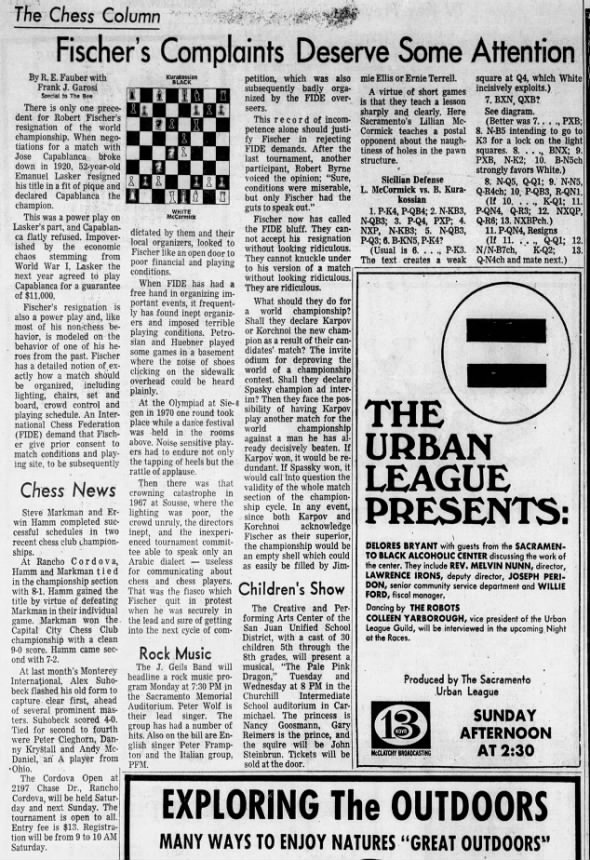 The Chess Column Sun, Jul 14, 1974 – 60 · The Sacramento Bee (Sacramento, California) · Newspapers.com
The Chess Column Sun, Jul 14, 1974 – 60 · The Sacramento Bee (Sacramento, California) · Newspapers.com
The Chess Column: Fischer's Complaints Deserve Some Attention
By R.E. Fauber with Frank J. Garosi
There is only one precedent for Robert Fischer's resignation of the world championship. When negotiations for a match with Jose Capablanca broke down in 1920, 52-year-old Emanuel Lasker resigned his title in a fit of pique and declared Capablanca the champion.
This was a power play on Lasker's part, and Capablanca flatly refused. Impoverished by the economic chaos stemming from World War I, Lasker the next year agreed to play Capablanca for a guarantee of $11,000.
Fischer's resignation is also a power play and, like most of his non-chess behavior, is modeled on the behavior of one of his heroes from the past. Fischer has a detailed notion of exactly how a match should be organized, including lighting, chairs, set and board, crowd control and playing schedule. An International Chess Federation (FIDE) demand that Fischer give prior consent to match conditions and playing site, to be subsequently dictated by them and their local organizers, looked to Fischer like an open door to poor financial and playing conditions.
When FIDE has had a free hand in organizing important events, it frequently has found inept organizers and imposed terrible playing conditions. Petrosian and Huebner played some games in a basement where the noise of shoes clicking on the sidewalk overhead could be heard plainly.
At the Olympiad at Siegen in 1970 one round took place while a dance festival was held in the rooms above. Noise sensitive players had to endure not only the tapping of heels but the rattle of applause.
Then there was that crowning catastrophe in 1967 at Sousse, where the lighting was poor, the crowd unruly, the directors inept, and the inexperienced tournament committee able to speak only an Arabic dialect — useless for communicating about chess and chess players. That was the fiasco which Fischer quit in protest when he was securely in the lead and sure of getting into the next cycle of competition, which was also subsequently badly organized by the FIDE overseers.
This record of incompetence alone should justify Fischer in rejecting FIDE demands. After the last tournament, another participant, Robert Byrne voiced the opinion: “Sure, conditions were miserable, but only Fischer had the guts to speak out.”
Fischer now has called the FIDE bluff. They cannot accept his resignation without looking ridiculous. They cannot knuckle under to his version of a match without looking ridiculous. They are ridiculous.
What should they do for a world championship? Shall they declare Karpov or Korchnoi the new champion as a result of their candidates' match? Then invite odium for deproving the world of a championship contest. Shall they declare Spassky champion ad interim? Then they face the possibility of having Karpov play another match for the world championship against a man he has already decisively beaten. If Karpov won, it would be redundant. If Spassky won, it would call into question the validity of the whole match section of the championship cycle. In any event, since both Karpov and Korchnoi acknowledge Fischer as their superior, the championship would be an empty shell which could as easily be filled by Jimmie Ellis or Ernie Terrell.
< Prev Index Next >
 Chess Sat, Dec 4, 1971 – 19 · The Lompoc Record (Lompoc, California) · Newspapers.com
Chess Sat, Dec 4, 1971 – 19 · The Lompoc Record (Lompoc, California) · Newspapers.com
Chess by Vaughn Proctor
Chess editor
(Lompoc Valley Chess Club meets Wednesdays, 7 p.m. and Saturdays, 10 a.m. to noon in the Community Building, 217 W. Maple Ave. All those interested in chess are cordially invited.)
There may be some truth to the theory that at least a small part of Bobby Fischer's invincibility results from his fantastic tournament performance. Opponents, so the theory goes are literally hexed into blunders or miss opportunities.
It will take a long time, but analysis tending to show this is beginning to come in on the Fischer-Larsen, and Fischer-Petrosian matches. There are some interesting comments on some of the games in the California Chess Reporter. The magazine under the editorship of Guthrie McClain, is fast becoming an important theoretical journal.
In the July-August issue, Tasks editor Robert E. Burger effectively shows that Bent Larsen, Fischer's opponent and one of the world's ranking players missed opportunities in the second and sixth games of the match won by Fischer, 6-0.
The California Chess Reporter, July-August 1971
http://www.chessdryad.com/articles/ccr/V21N1.pdf
In the September-October issue, Burger notes some analysis by Hy Gordon which tends to show that Tigran Petrosian, Russian star and final victim of Fischer en route to a title match with Boris Spassky, could have equalized and perhaps ended on top in the first game won by Fischer. Likewise, Burger shows some analysis tending to show that Fischer might have won the eighth game against Petrosian in considerably fewer moves than the 66 he required.
The California Chess Reporter, September-October 1971, Page 37
Winning Chess Concepts by Hyman Gordon
http://www.chessdryad.com/articles/ccr/V21N2.pdf
Burger's analysis and diagrams, plus the notation from the relevant games will be available to review this morning at the Chess Club's Saturday session.
< Prev Index Next >
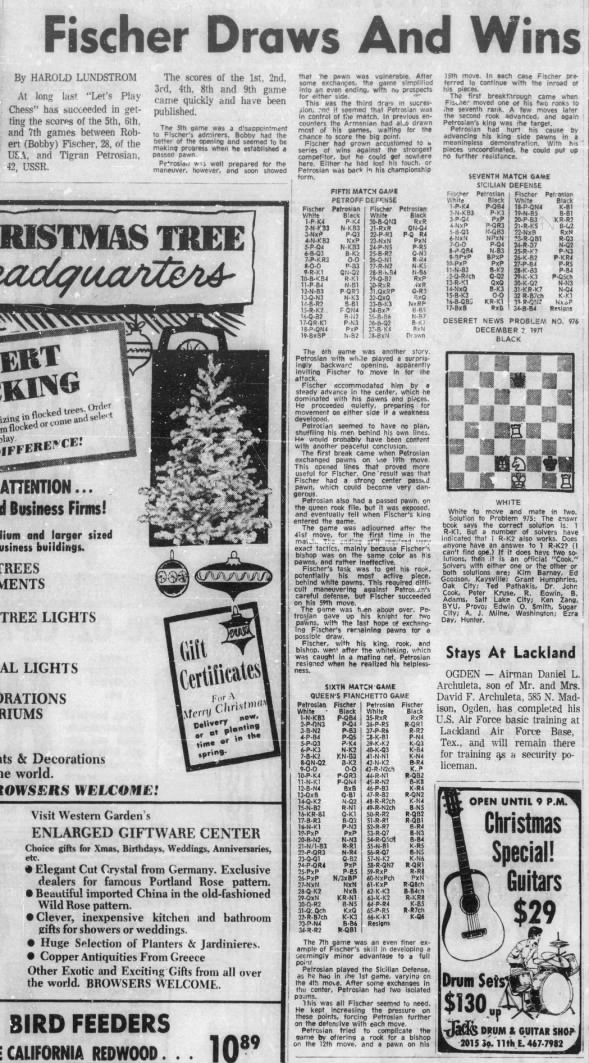 Chess Fri, Dec 3, 1971 – 16 · Deseret News (Salt Lake City, Utah) · Newspapers.com
Chess Fri, Dec 3, 1971 – 16 · Deseret News (Salt Lake City, Utah) · Newspapers.com
Let's Play Chess by Harold Lundstrom Friday, December 03, 1971 Deseret News Salt Lake City, Utah Deseret News Problem...
Posted by Bobby Fischer's True History on Wednesday, November 25, 2020
Deseret News Problem No. 976. White to move and mate in two.
FEN 8/4q3/8/8/4R3/8/3QN1k1/4K2R w - - 0 1
Key: N-B4/Nf4+
Let's Play Chess: Fischer Draws And Wins by Harold Lundstrom
At long last “Let's Play Chess” has succeeded in getting the scores of the 5th, 6th, and 7th games between Robert (Bobby) Fischer, 28, of the USA and Tigran Petrosian, 42, USSR.
The scores of the 1st, 2nd, 3rd, 4th, 8th and 9th game came quickly and have been published.
The 5th game was a disappointment to Fischer's admirers. Bobby had the better of the opening and seemed to be making progress when he established a passed pawn.
Petrosian was well prepared for the maneuver, however, and soon showed that the pawn was vulnerable. After some exchanges, the game simplified into an even ending, with no prospects for either side.
This was the third draw in succession, and it seemed that Petrosian was in control of the match. In previous encounters the Armenian had also drawn most of his games, waiting for the chance to score the big point.
Fischer had grown accustomed to a series of wins against the strongest competitor, but he could get nowhere here. Either he had lost his touch, or Petrosian was back in his championship form.
The 6th game was another story. Petrosian with white played a surprising backward opening, apparently inviting Fischer to move in for the attack.
Fischer accommodated him by a steady advance in the center, which he dominated with his pawns and pieces.
He proceeded quietly, preparing for movement on either side if a weakness developed.
Petrosian seemed to have no plan, shuffling his men behind his own lines. He would probably have been content with another peaceful conclusion.
The first break came when Petrosian exchanged pawns on the 19th move. This opened lines that proved more useful for Fischer. One result was that Fischer had a strong center passed pawn, which could become very dangerous.
Petrosian also had a passed pawn, on the queen rook file, but it was exposed, and eventually fell when Fischer's king entered the game.
The game was adjourned after the 41st move, for the first time in the match. The ending still required very exact tactics, mainly because Fischer's bishop was on the same color as his pawns, and rather ineffective.
Fischer's task was to get his rook, potentially his most active piece, behind white pawns. This required difficult maneuvering against Petrosian's careful defense, but Fischer succeeded on his 59th move.
The game was then about over. Petrosian gave up his knight for two pawns, with the last hope of exchanging Fischer's remaining pawns for a possible draw.
Fischer, with his king, rook, and bishop, went after the white king, which was caught in a mating net. Petrosian resigned when he realized his helplessness.
The 7th game was an even finer example of Fischer's skill in developing a seemingly minor advantage to a full point.
Petrosian played the Sicilian Defense, as he had in the 1st game, varying on the 4th move. After some exchanges in the center, Petrosian had two isolated pawns.
This was all Fischer seemed to need. He kept increasing the pressure on these points, forcing Petrosian further on the defensive with each move.
Petrosian tried to complicate the game by offering a rook for a bishop on the 12th move, and a pawn on his 15th move. In each case Fischer preferred to continue with the inroad of his pieces.
The first breakthrough came when Fischer moved one of his two rooks to the seventh rank. A few moves later the second rook advanced, and again Petrosian's king was the target.
Petrosian had hurt his cause by advancing his king side pawns in a meaningless demonstration. With his pieces uncoordinated, he could put up no further resistance.
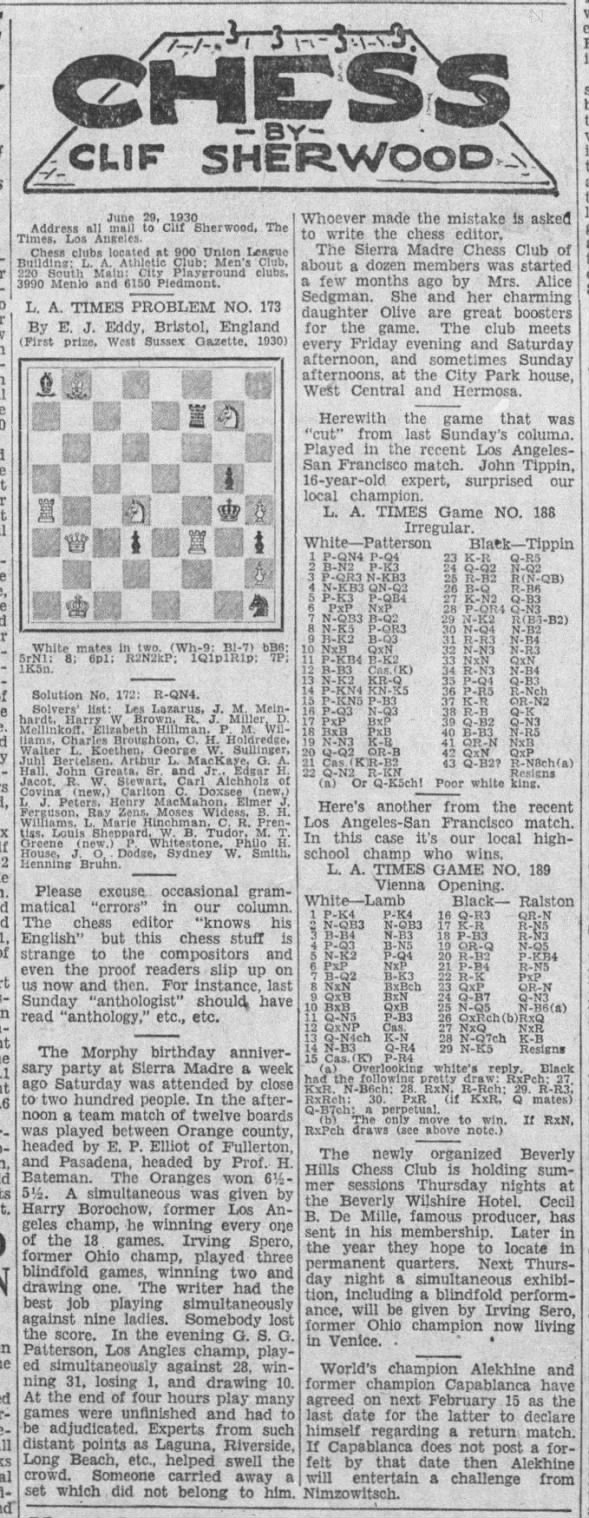 Chess by Clif Sherwood Sun, Jun 29, 1930 – 72 · The Los Angeles Times (Los Angeles, California) · Newspapers.com
Chess by Clif Sherwood Sun, Jun 29, 1930 – 72 · The Los Angeles Times (Los Angeles, California) · Newspapers.com
Chess by Clif Sherwood Sunday, June 29, 1930 The Los Angeles Times Los Angeles, California L.A. Times Problem No. 173...
Posted by Bobby Fischer's True History on Wednesday, November 25, 2020
L.A. Times Problem No. 173 by E.J. Eddy, Bristol, England. First prize, West Sussex Gazette, 1930. White mates in two.
FEN bB6/5rN1/8/6p1/R2N2kP/1Q1p1R1p/7P/1K5n w - - 0 1
Key: Q-Q/Qd1
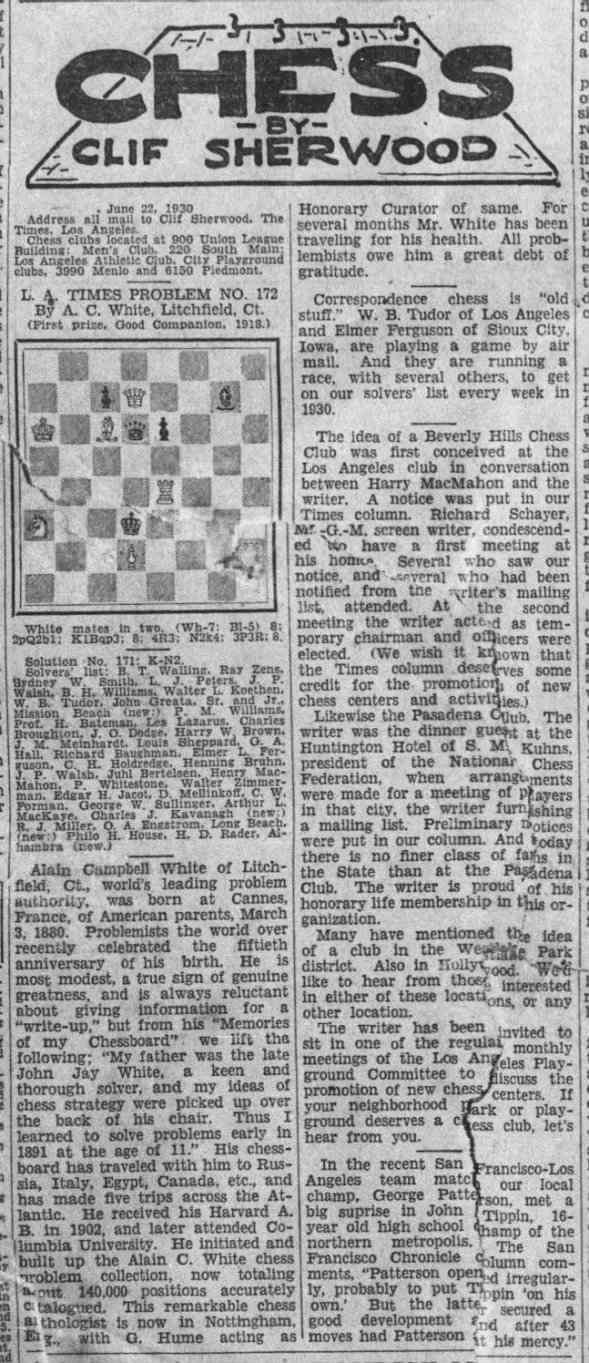 Chess by Clif Sherwood Sun, Jun 22, 1930 – 76 · The Los Angeles Times (Los Angeles, California) · Newspapers.com
Chess by Clif Sherwood Sun, Jun 22, 1930 – 76 · The Los Angeles Times (Los Angeles, California) · Newspapers.com
Chess by Clif Sherwood Sunday, June 22, 1930 The Los Angeles Times Los Angeles, California L.A. Times Problem No. 172...
Posted by Bobby Fischer's True History on Wednesday, November 25, 2020
L.A. Times Problem No. 172 by A.C. White, Litchfield, Ct. First prize, Good Companion, 1918.
FEN 8/2pQ2b1/K1Bqp3/8/4R3/N2k4/3P3R/8 w - - 0 1
Key: R-QN4/Rb4
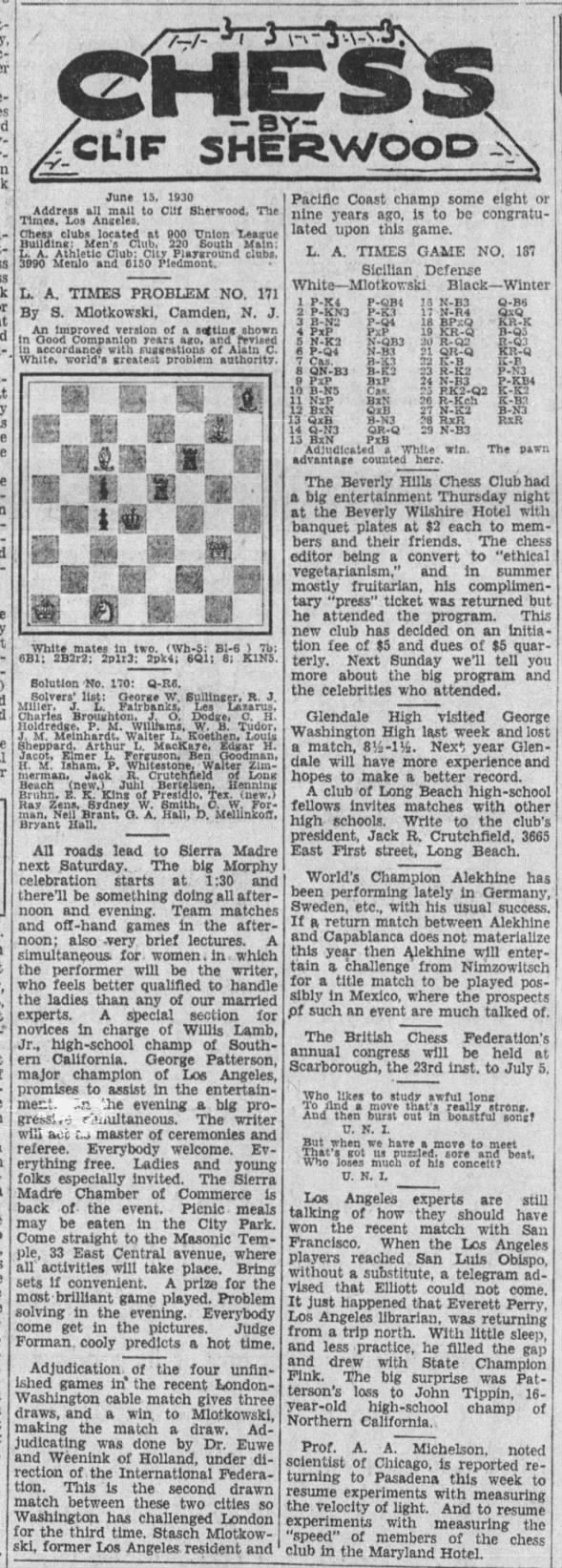 Chess by Clif Sherwood Sun, Jun 15, 1930 – 82 · The Los Angeles Times (Los Angeles, California) · Newspapers.com
Chess by Clif Sherwood Sun, Jun 15, 1930 – 82 · The Los Angeles Times (Los Angeles, California) · Newspapers.com
Chess by Clif Sherwood Sunday, June 15, 1930 The Los Angeles Times Los Angeles, California L.A. Times Problem No. 171...
Posted by Bobby Fischer's True History on Wednesday, November 25, 2020
L.A. Times Problem No. 171 by S. Molotkowski, Camden, N.J. An improved version of a setting shown in Good Companion years ago, and revised in accordance of Alain C. White, world's greatest problem authority. White mates in two.
FEN 7b/6B1/2B2r2/2p1r3/2pk4/6Q1/8/K1N5 w - - 0 1
Key: K-N2/Kb2
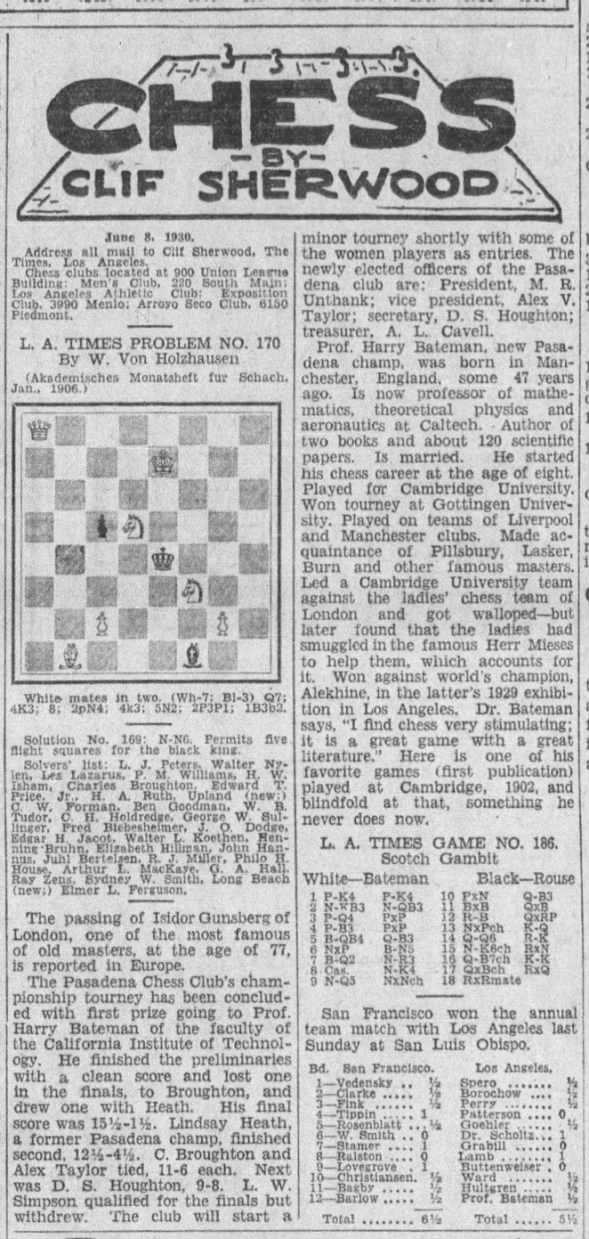 Chess by Clif Sherwood Sun, Jun 8, 1930 – 78 · The Los Angeles Times (Los Angeles, California) · Newspapers.com
Chess by Clif Sherwood Sun, Jun 8, 1930 – 78 · The Los Angeles Times (Los Angeles, California) · Newspapers.com
Chess by Clif Sherwood Sunday, June 08, 1930 The Los Angeles Times Los Angeles, California L.A. Times Problem No. 170...
Posted by Bobby Fischer's True History on Wednesday, November 25, 2020
L.A. Times Problem No. 170 by W. Von Holzhausen, Akademisches Monatscheft fur Schach, January, 1906. White mates in two.
FEN Q7/4K3/8/2pN4/4k3/5N2/2P3P1/1B3b2 w - - 0 1
Key: Q-R6/Qa6
lol "Professor Harry Bateman ... Led a Cambridge University team against the ladies' chess team of London and got...
Posted by Bobby Fischer's True History on Wednesday, November 25, 2020
Professor Harry Bateman ... Led a Cambridge University team against the ladies' chess team of London and got walloped--but later found that the ladies had smuggled in the famous Herr Mieses to help them, which accounts for it.
Won against world's champion Alekhine, in the latter's 1929 exhibition in Los Angeles. Dr. Bateman says, “I find chess very stimulating; it is a great game with a great literature.” Here is one of his favorite games (first publication) played at Cambridge, 1902, and blindfold at that, something he never does now.
L.A. Times Game No. 186.
Scotch Gambit
White (Bateman) vs. Black (Rouse)
Descriptive 1. P-K4 P-K4 2. N-KB3 N-QB3 3. P-Q4 PxP 4. P-B3 PxP 5. B-QB4 Q-B3 6. NxP B-N5 7. B-Q2 N-R3 8. O-O N-K4 9. N-Q5 NxNch 10. PxN Q-B3 11. BxB QxB 12. R-B QxRP 13. NxPch K-Q 14. Q-Q6 R-K 15. N-K6ch RxN 16. Q-B7ch K-K 17. QxBch RxQ 18. RxR mate |
Algebraic 1. e4 e5 2. Nf3 Nc6 3. d4 exd4 4. c3 dxc3 5. Bc4 Qf6 6. Nxc3 Bb4 7. Bd2 Nh6 8. 0-0 Ne5 9. Nd5 Nxf3+ 10. gxf3 Qc6 11. Bxb4 Qxc4 12. Rc1 Qxa2 13. Nxc7+ Kd8 14. Qd6 Re8 15. Ne6+ Rxe6 16. Qc7+ Ke8 17. Qxc8+ Rxc8 18. Rxc8# |
 Chess by Clif Sherwood Sun, Jun 1, 1930 – 77 · The Los Angeles Times (Los Angeles, California) · Newspapers.com
Chess by Clif Sherwood Sun, Jun 1, 1930 – 77 · The Los Angeles Times (Los Angeles, California) · Newspapers.com
Chess by Clif Sherwood Sunday, June 01, 1930 The Los Angeles Times Los Angeles, California L.A. Times Problem No. 169...
Posted by Bobby Fischer's True History on Wednesday, November 25, 2020
L.A. Times Problem No. 169 by Reverend A.C. Pearson. From the Two-Move Chess Problem. White mates in two.
FEN 4K3/1p5B/1P1B3R/P1pkN3/P4P2/2p1p3/2NnP3/3R4 w - - 0 1
Key: N-N6/Ng6
Permits five flight squares for the black king.
Chess by Clif Sherwood Sunday, June 01, 1930 The Los Angeles Times Los Angeles, California End game by Dr. Emanuel...
Posted by Bobby Fischer's True History on Wednesday, November 25, 2020
End game by Dr. Emanuel Lasker. White to play and draw.
FEN 8/8/3N4/n1krn3/8/6K1/N1P5/1R1r4 w - - 0 1
One difference between problems and end-games is that in the latter a check or capture on the first move is forgivable. The main variation in the above: 1. R-N5ch, KxN; 2. RxRch RxR; 3. N-B3 draws. (i.e., 1. Rb5+ Kxd6 2. Rxd5+ Rxd5 3. Nc3 drawn)
< Prev Index Next >
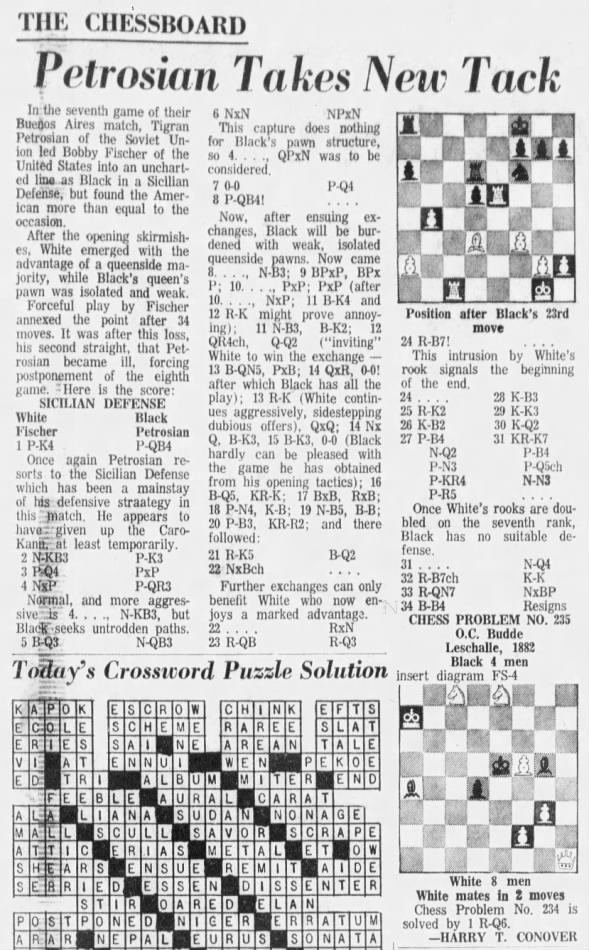 The Chessboard Sun, Nov 28, 1971 – Page 44 · Asbury Park Press (Asbury Park, New Jersey) · Newspapers.com
The Chessboard Sun, Nov 28, 1971 – Page 44 · Asbury Park Press (Asbury Park, New Jersey) · Newspapers.com
The Chessboard: Petrosian Takes New Tack by Harry T. Conover
In the seventh game of their Buenos Aires match, Tigran Petrosian of the Soviet Union led Bobby Fischer of the United States into an uncharted line as Black in a Sicilian Defense, but found the American more than equal to the occasion.
After the opening skirmishes, White emerged with the advantage of a queenside majority, while Black's queen's pawn was isolated and weak.
Forceful play by Fischer annexed the point after 34 moves. It was after this loss, his second straight, that Petrosian became ill, forcing postponement of the eighth game.
Here is the score:
Robert James Fischer vs Tigran Vartanovich Petrosian Fischer - Petrosian Candidates Final (1971), Buenos Aires ARG, rd 7, Oct-19 Sicilian Defense: Kan. Modern Variation (B42) 1-0 https://www.chessgames.com/perl/chessgame?gid=1044351 23. … Rd6
1. e4 c5
Once again Petrosian resorts to the Sicilian Defense which has been a mainstay of his defensive strategy in this match. He appears to have given up the Caro-Kann, at least temporarily.
2. Nf3 e6
3. d4 cxd4
4. Nxd4 a6
Normal, and more aggressive is 4. … N-KB3, but Black seeks untrodden paths.
5. Bd3 Nc6
6. Nxc6 bxc6
This capture does nothing for Black's pawn structure, so 4. … QPxN was to be considered.
7. O-O d5
8. c4 …
Now, after ensuing exchanges, Black will be burdened with weak, isolated queenside pawns. Now came
8. … Nf6
9. cxd5 cxd5 (10. … NxP; 11. B-K4 and 12. R-K might prove annoying)
10. exd5 exd5
11. Nc3 Be7
12. Qa4+ Qd7 (“inviting” White to win the exchange — 13. B-QN5, PxB; 14. QxR, O-O! after which Black has all the play)
13. Re1 …
White continues aggressively, sidestepping dubious offers.
13. … Qxa4
14. Nxa4 Be6
15. Be3 O-O
Black hardly can be pleased with the game he has obtained from his opening tactics.
16. Bc5 Rfe8
17. Bxe7 Rxe7
18. b4 Kf8
19. Nc5 Bc8
20. f3 Rea7
and there followed:
21. Re5 Bd7
22. Nxd7+ …
Further exchanges can only benefit White who now enjoys a marked advantage.
22. … Rxd7
23. Rc1 Rd6
24. Rc7! …
This intrusion by White's rook signals the beginning of the end.
24. … Nd7
25. Re2 g6
26. Kf2 h5
27. f4 h4
28. Kf3 f5
29. Ke3 d4+
30. Kd2 Nb6
31. Ree7 …
Once White's rooks are doubled on the seventh rank, Black has no suitable defense.
31 … Nd5
32. Rf7+ Ke8
33. Rb7 Nxf4
34. Bc4 Resigns
< Prev Index Next >
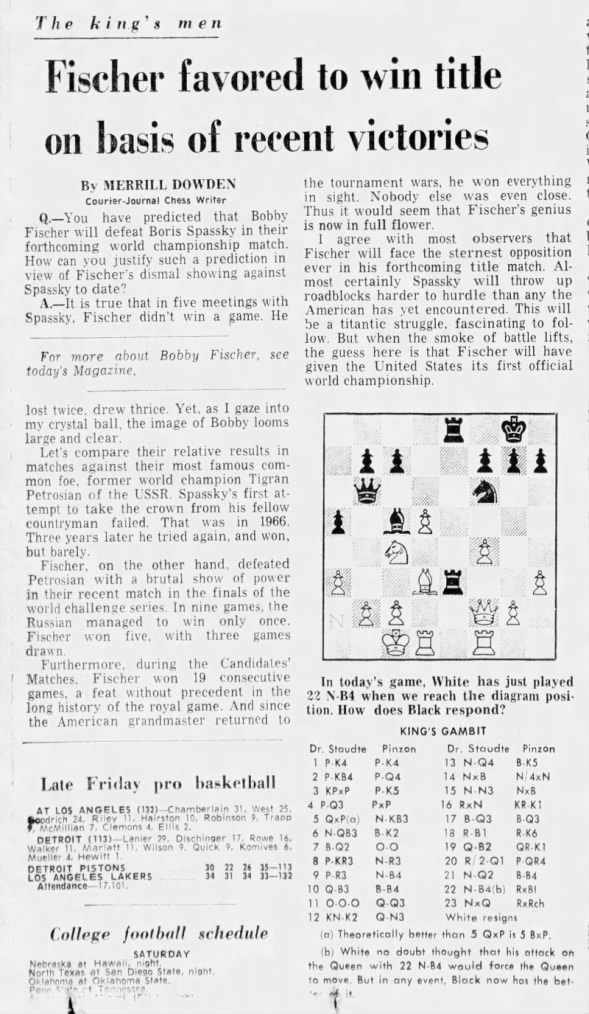 The King's Men Sun, Nov 28, 1971 – Page 7 · The Courier-Journal (Louisville, Kentucky) · Newspapers.com
The King's Men Sun, Nov 28, 1971 – Page 7 · The Courier-Journal (Louisville, Kentucky) · Newspapers.com
The King's Men
Fischer Favored to Win Title On Basis of Recent Victories by Merrill Dowden
Q.—You have predicted that Bobby Fischer will defeat Boris Spassky in their forthcoming world championship match. How can you justify such a prediction in view of Fischer's dismal showing against Spassky to date?
A.—It is true that in five meetings with Spassky, Fischer didn't win a game. He lost twice, drew thrice. Yet, as I gaze into my crystal ball, the image of Bobby looms large and clear.
Let's compare their relative results in matches against their most famous common foe, former world champion Tigran Petrosian of the USSR. Spassky's first attempt to take the crown from his fellow countryman failed. That was in 1966. Three years later he tried again, and won, but barely.
Fischer, on the other hand, defeated Petrosian with a brutal show of power in their recent match in the finals of the world challenge series. In nine games, the Russian managed to win only once. Fischer won five, with three games drawn.
Furthermore, during the Candidates' Matches, Fischer won 19 consecutive games, a feat without precedent in the long history of the royal game. And since the American grandmaster returned to the tournament wars, he won everything in sight. Nobody else was even close. Thus, it would seem that Fischer's genius is now in full flower.
I agree with most observers that Fischer will face the sternest opposition ever in his forthcoming title match. Almost certainly Spassky will throw up roadblocks harder to hurdle than any the American has yet encountered. This will be a titanic struggle, fascinating to follow. But when the smoke of battle lifts, the guess here is that Fischer will have given the United States its first official world championship.
< Prev Index Next >
 Chess Sat, Nov 27, 1971 – 39 · Times Colonist (Victoria, British Columbia, Canada) · Newspapers.com
Chess Sat, Nov 27, 1971 – 39 · Times Colonist (Victoria, British Columbia, Canada) · Newspapers.com
Chess by George Koltanowski Saturday, November 27, 1971 Times Colonist Victoria, British Columbia, Canada White to play...
Posted by Bobby Fischer's True History on Monday, November 23, 2020
White to play and mate in two moves.
FEN 4nQ2/K6B/pN2pP1R/r2Nk3/3bn3/6Pp/1B2b3/4Rr1q w - - 0 1
Key: N-N4/Nb4
Bobby Proves Not Invincible
First in Vancouver against Russia's Mark Taimanov; then in Denver against Denmark's Bent Larsen, Bobby Fischer had seemed absolutely unbeatable. He won 12 games in a row, obliterating both these formidable obstacles in his path to the World Championship Candidates' finals in Buenos Aires. And his first game there, against Tigran Petrosian, continued the string.
But after 13 candidates' wins, Fischer's string broke — and here's the game that did it. (Each side tried to get the other to exchange Queens; both avoided it!)
Tigran Vartanovich Petrosian vs Robert James Fischer Fischer - Petrosian Candidates Final (1971), Buenos Aires ARG, rd 2, Oct-05 Gruenfeld Defense: Brinckmann Attack (D82) 1-0 https://www.chessgames.com/perl/chessgame?gid=1044714
1. d4 Nf6
2. c4 g6
3. Nc3 d5
4. Bf4 Bg7
5. e3 c5
6. dxc5 Qa5
7. Rc1 Ne4
8. cxd5 Nxc3
9. Qd2(a) Qxa2
10. bxc3 Qa5(b)
(b) Exchanging Queens here gives White the advantage of a pawn plus better center possibilities.
11. Bc4 Nd7
12. Ne2 Ne5
13. Ba2 Bf5(c)
14. Bxe5 Bxe5
15. Nd4 Qxc5
16. Nxf5 gxf5
17. O-O Qa5
18. Qc2 f4
19. c4 fxe3
20. c5(d) Qd2
21. Qa4+ Kf8
22. Rcd1 Qe2
23. d6 Qh5
24. f4 e2
25. fxe5 exd1=Q
26. Rxd1 Qxe5
27. Rf1 f6
28. Qb3 Kg7
29. Qf7+ Kh6
30. dxe7 f5
31. Rxf5 Qd4+
32. Kh1 1-0
< Prev Index Next >
 Chess Sat, Nov 27, 1971 – 28 · Star-Phoenix (Saskatoon, Saskatchewan, Canada) · Newspapers.com
Chess Sat, Nov 27, 1971 – 28 · Star-Phoenix (Saskatoon, Saskatchewan, Canada) · Newspapers.com
Chess: How They Decide Who's Who by Harry Mather
Although perhaps the oldest game on record, chess, on the international scale, is among the most up to date in the matter of rating or grading its players. This fact is illustrated clearly by the recently published international rating list in Canada's official chess magazine, Chess Chat. Individual countries have, for many years, had their own national rating systems in which their own nationals were rated according to playing strength. Some of these used the category system and grouped their players as grandmasters, masters, and experts, etc., while other countries sought to grade their players according to numerical means.
However, during the past two years, the world chess organization agreed on an international scheme, evolved by U.S. statistician Prof. Elo, and the most recent list evaluates the relative strength of about 600 of the world's leading players from the various countries. Like any rating scheme, the method is based on a player's score in tournaments plus the strength of his opposition.
The top 10 are listed below — with nationality and rating in brackets: Fischer (U.S.A. - 2,760); Spassky (USSR - 2,690); Korchnoi (USSR - 2,670). Larsen (Denmark - 2,660); Petrosian and Polugaevsky (USSR) - 2,640); Botvinnik and Portisch (USSR - 2,630); and Smyslov and Tal (USSR) - 2,620).
Canada has eight players internationally listed — the first five being Suttles (2,480), Amos and Yanofsky (2,460), Vrenasic (2,450), and former Saskatonian, Denis Allan, with 2,380.
Rating lists are not confined to the international level, but are carried on down to the duffer class by the various individual countries. Thus, while Canada has only eight players on the international list, it has hundreds of rated players on the national scale.
Saskatchewan has but two players above the 2,000 class; and it is significant that both these players (Henry Andres and Dr. Markov) were co-winners of the Saskatchewan championship held two weeks ago.
So while a player's rating is certainly no guarantee of his success (or failure) in a tournament, it does seem to be a reasonable good measure of his over-all ability in many cases.
< Prev Index Next >
 The Game of Kings Sat, Nov 27, 1971 – 55 · The Gazette (Montreal, Quebec, Canada) · Newspapers.com
The Game of Kings Sat, Nov 27, 1971 – 55 · The Gazette (Montreal, Quebec, Canada) · Newspapers.com
The Game of Kings by D.M. LeDain Saturday, November 27, 1971 The Gazette Montreal, Quebec, Canada Problem No. 1275 by...
Posted by Bobby Fischer's True History on Monday, November 23, 2020
Problem No. 1275 by E. Livsic, U.S.S.R. White mates in two moves.
FEN 1b3RK1/1r2p3/1Q1n2kp/3B3p/p6B/r1p3n1/2R5/1b6 w - - 0 1
Key: R-KN2/Rg2
Montreal, Chess Capital?
Four countries have already put in a bid for the Fischer-Spassky world championship match, one of which has offered $30,000.00 prize money (winner, $18,000, loser, $12,000.) The International Chess Federation (FIDE) has not disclosed names as other bids are expected. The expenditure is very small compared to other professional sports for world wide publicity that could last six weeks or more (the winner must score 12½ pts. in the best of 24 games series, with three games per week). Money will not be the sole criterion of suitability., and a wrangle can be expected on that point. If agreement as to site cannot be reached amicably between the principals the names will ahve to go into a hat for a decision, as was the case for the Buenos Aires match. Fortunately they offered the biggest prize and the Argentine government picked up the tab. But why not Montreal? Both players are well-known and well-liked here and as neutral an atmosphere could be expected as anywhere else in the world. The project would still require the support of government and business. Montreal staged the last section of games in the world championship match of 1894, when Emmanuel Lasker, 24, dethroned William Steinitz, 57, ending a reign of 28 years. FIDE has ruled the match must not start before April 28 or later than July 1.
< Prev Index Next >
 Chess Master Thu, Nov 25, 1971 – 52 · The Indianapolis News (Indianapolis, Indiana) · Newspapers.com
Chess Master Thu, Nov 25, 1971 – 52 · The Indianapolis News (Indianapolis, Indiana) · Newspapers.com
Chess Master by George Koltanowski Thursday, November 25, 1971 The Indianapolis News Indianapolis, Indiana Problem by...
Posted by Bobby Fischer's True History on Sunday, November 22, 2020
Problem by A. Mari, Italy. White to play and mate in two moves.
FEN 4nQ2/K6B/pN2pP1R/r2Nk3/3bn3/6Pp/1B2b3/4Rr1q w - - 0 1
Key: N-N4/Nb4
Tigran Petrosian (White) vs. Robert Fischer (Black)
Grunfeld Defense
1. d4 Nf6 2. c4 g6 3. Nc3 d5 4. Bf4 Bg7 5. e3 c5 6. dxc5 Qa5 7. Rc1 Ne4 8. cxd5 Nxc3 9. Qd2(a) Qxa2 10. bxc3 Qa5(b) 11. Bc4 Nd7 12. Ne2 Ne5 13. Ba2 Bf5(c) 14. Bxe5 Bxe5 15. Nd4 Qxc5 16. Nxf5 gxf5 17. O-O Qa5 18. Qc2 f4 19. c4 fxe3 20. c5(d) Qd2 21. Qa4+ Kf8 22. Rcd1 Qe2 23. d6 Qh5 24. f4 e2 25. fxe5 exd1=Q 26. Rxd1 Qxe5 27. Rf1 f6 28. Qb3 Kg7 29. Qf7+ Kh6 30. dxe7 f5 31. Rxf5 Qd4+ 32. Kh1 1-0
(a) Now Black must decide which pawns he wants to take.
(b) Exchanging Queens here gives White the advantage of a pawn plus better center possibilities.
(c) 13. … QxBP4 was best here.
(d) Petrosian is now playing powerful chess. Black hardly dares castle either side and the onward march of the center pawns makes things look tough for Black, who puts up a gallant fight.
Tigran Vartanovich Petrosian vs Robert James Fischer Fischer - Petrosian Candidates Final (1971), Buenos Aires ARG, rd 2, Oct-05 Gruenfeld Defense: Brinckmann Attack (D82) 1-0 https://www.chessgames.com/perl/chessgame?gid=1044714
 Chess by Clif Sherwood Sun, May 25, 1930 – 76 · The Los Angeles Times (Los Angeles, California) · Newspapers.com
Chess by Clif Sherwood Sun, May 25, 1930 – 76 · The Los Angeles Times (Los Angeles, California) · Newspapers.com
Chess by Clif Sherwood Sunday, May 25, 1930 The Los Angeles Times Los Angeles, California L.A. Times Problem No. 168 by...
Posted by Bobby Fischer's True History on Saturday, November 21, 2020
L.A. Times Problem No. 168 by S. Mlotkowski, Camden, N.J. First publication. White mates in two.
FEN 4Kb1B/4NB1p/4N2k/8/7r/5Q1b/6r1/4q3 w - - 0 1
Key: Q-N4/Qg4
Chess by Clif Sherwood Sunday, May 25, 1930 The Los Angeles Times Los Angeles, California Endgame by Henri Rinck. White...
Posted by Bobby Fischer's True History on Saturday, November 21, 2020
Endgame by Henri Rinck. White to play and win. White can't stop the black pawn from queening so other measures must be taken as follows: 1. N-N4 P-K8(Q); 2. B-Q4ch (if QxB; 3.N-B6ch wins; 1. Nb4 d1=Q 2. Bd4+ Qxd4 3. Nc6+) K-R; 3. N-R6! (if Q-B7ch; 4. N-B7ch wins) QxB; 4. N-B7ch K-R2; 5. N-N5ch wins.
FEN 2K5/k7/8/4B3/5p2/7P/2Np4/8 w - - 0 1
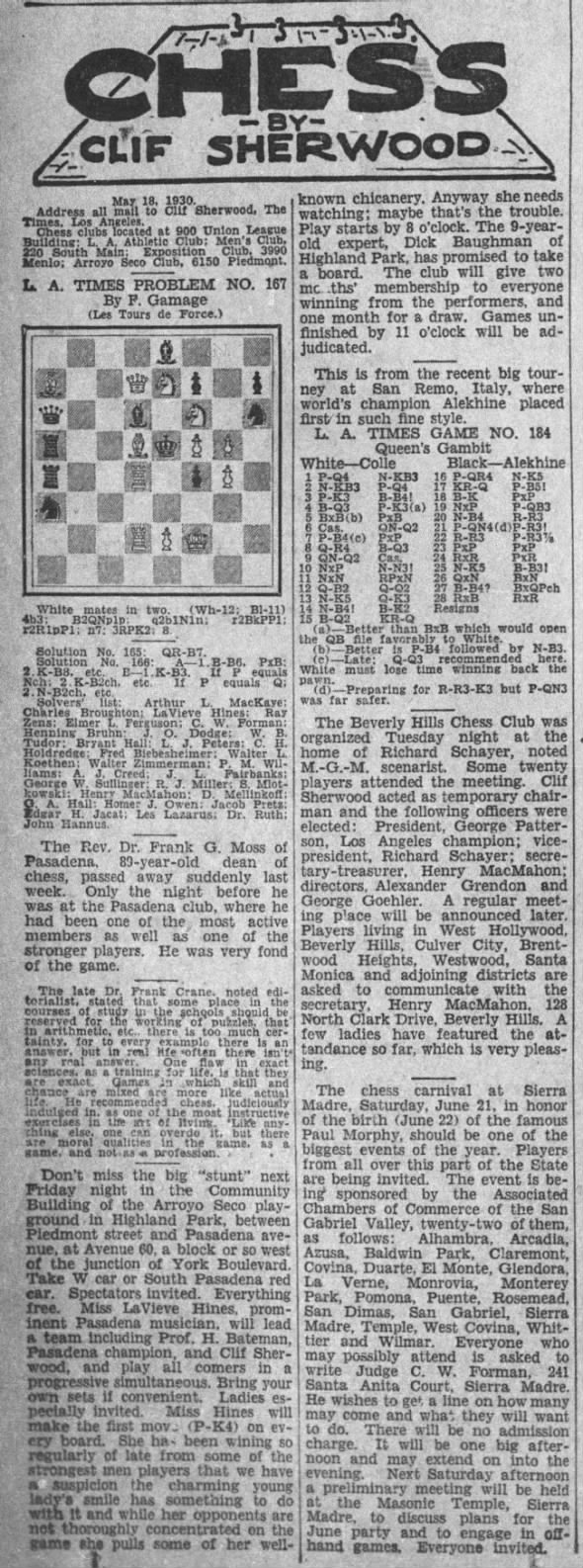 Chess by Clif Sherwood Sun, May 18, 1930 – 82 · The Los Angeles Times (Los Angeles, California) · Newspapers.com
Chess by Clif Sherwood Sun, May 18, 1930 – 82 · The Los Angeles Times (Los Angeles, California) · Newspapers.com
Chess by Clif Sherwood Sunday, May 18, 1930 The Los Angeles Times Los Angeles, California L.A. Times Problem No. 167 by...
Posted by Bobby Fischer's True History on Saturday, November 21, 2020
L.A. Times Problem No. 167 by F. Gamage. Les Tours de Force. White mates in two.
FEN 4b3/B2QNp1p/q2b1N1n/r2BkPP1/r2R1pP1/n7/3RPK2/8 w - - 0 1
Key: B-B6/Bc6
 Chess by Clif Sherwood Sun, May 11, 1930 – 82 · The Los Angeles Times (Los Angeles, California) · Newspapers.com
Chess by Clif Sherwood Sun, May 11, 1930 – 82 · The Los Angeles Times (Los Angeles, California) · Newspapers.com
Chess by Clif Sherwood Sunday, May 11, 1930 The Los Angeles Times Los Angeles, California L.A. Times Problem No. 165 by...
Posted by Bobby Fischer's True History on Saturday, November 21, 2020
L.A. Times Problem No. 165 by Godfrey Heathcote. First prize—Hampstead and Highgate Express, 1905. Shows eight variations through eight possible moves to black N without any capture of the N. White mates in two.
FEN 6K1/pN2R1PQ/p7/r2k3r/N2n4/1P2p3/BB5p/2Rb2bq w - - 0 1
Key: QR-B7/Rcc7
Chess by Clif Sherwood Sunday, May 11, 1930 The Los Angeles Times Los Angeles, California L.A. Times Problem No. 166....
Posted by Bobby Fischer's True History on Saturday, November 21, 2020
L.A. Times Problem No. 166. This neat miniature by Dr. Galitsky (Blumenthal's Schachminiaturen, 1903) originally had White K on K8. Later (May 1925) F. Bennett of Queensland in the Australian is credited by the British Chess Magazine with “Problem Twins” showing position below, a three-mover no matter which way the pawns are going—two distinct problems: so Bennett is composer of reverse position only. White mates in three.
FEN 7k/4K1pp/7N/8/8/8/8/B7 w - - 0 1
Key: A—1. B-B6 PxB 2. K-B8, etc.
1. Bf6 gxf6 2. Kf8 f5 3. Nf7#
B—1. K-B3. If P equals Q; 2. N-B2ch, etc.
 Chess by Clif Sherwood Sun, May 4, 1930 – 86 · The Los Angeles Times (Los Angeles, California) · Newspapers.com
Chess by Clif Sherwood Sun, May 4, 1930 – 86 · The Los Angeles Times (Los Angeles, California) · Newspapers.com
Chess by Clif Sherwood Sunday, May 04, 1930 The Los Angeles Times Los Angeles, California L.A. Times Problem No. 164 by...
Posted by Bobby Fischer's True History on Saturday, November 21, 2020
L.A. Times Problem No. 164 by S. Mlotkowski, Camden, N.J. Bethlehem Globe-Times, February 1930. White mates in two.
FEN 8/p2p4/Q1ppp2p/P2k3B/3p1PKP/3p3P/3n4/2R1R3 w - - 0 1
Key: R-K3/Re3
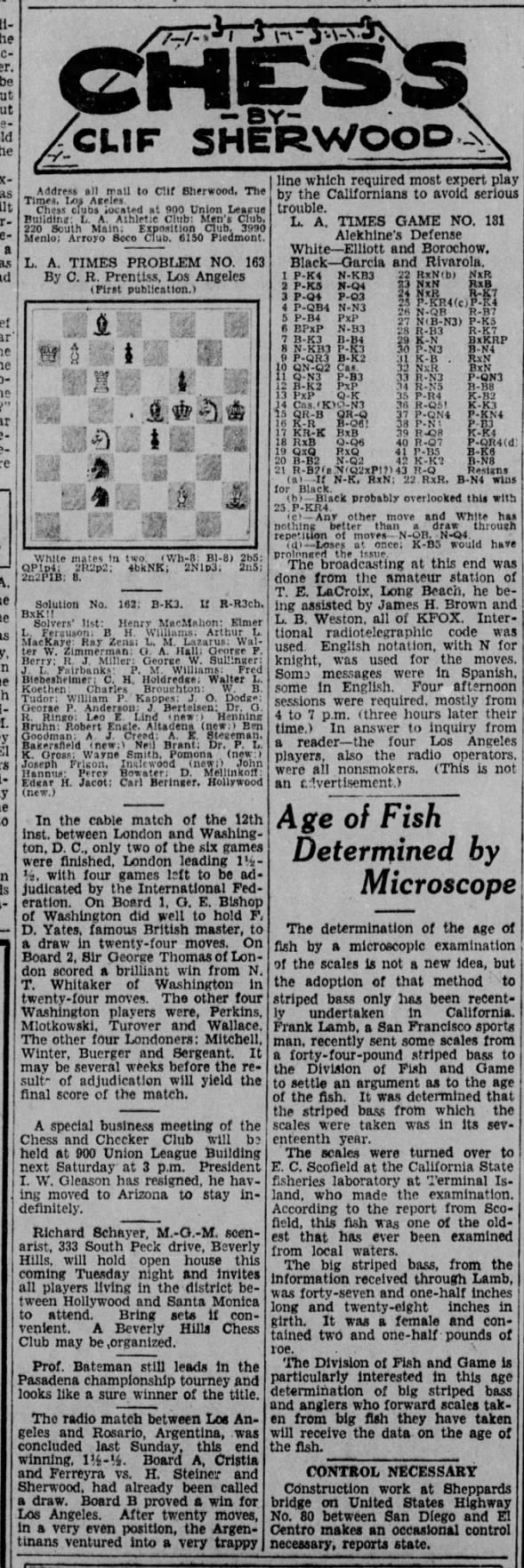 Chess by Clif Sherwood Sun, Apr 27, 1930 – 85 · The Los Angeles Times (Los Angeles, California) · Newspapers.com
Chess by Clif Sherwood Sun, Apr 27, 1930 – 85 · The Los Angeles Times (Los Angeles, California) · Newspapers.com
Chess by Clif Sherwood Sunday, April 27, 1930 The Los Angeles Times Los Angeles, California L.A. Times Problem No. 163...
Posted by Bobby Fischer's True History on Saturday, November 21, 2020
L.A. Times Problem No. 163 by C.R. Prentiss, Los Angeles. First publication. White mates in two.
FEN 2b5/QP1p4/2R2p2/4bkNK/2N1p3/2n5/2n2P1B/8 w - - 0 1
Key: Q-Q4/Qd4
The radio match between Los Angeles and Rosario, Argentina, was concluded last Sunday, this end winning 1½-½. Board A, Cristia and Ferreyra vs. H. Steiner and Sherwood, had already been called a draw. Board B proved a win for Los Angeles. After twenty moves, in a very even position, the Argentineans ventured into a very trappy line which required most expert play by the Californians to avoid serious trouble.
L.A. Times Game No. 181
Edward P. Elliott - Harry Borochow (white) vs. Oscar Garcia and J. Rivarola (black)
Alekhine Defense: Four Pawns Attack, Main Line
Descriptive 1. P-K4 N-KB3 2. P-K5 N-Q4 3. P-Q4 P-Q3 4. P-QB4 N-N3 5. P-B4 PxP 6. BPxP N-B3 7. B-K3 B-B4 8. N-KB3 P-K3 9. P-QR3 B-K2 10. QN-Q2 O-O 11. Q-N3 P-B3 12. B-K2 PxP 13. PxP Q-K 14. O-O Q-N3 15. QR-B QR-Q 16. K-R B-Q6 17. KR-K BxB 18. RxB Q-Q6 19. QxQ RxQ 20. B-B2 N-Q2 21. R-B2 NxP 22. RxN NxR 23. NxN RxB 24. NxR R-K7 25. P-KR4 P-K4 26. N-QB R-B7 27. N-N3 P-K5 28. R-B3 R-K7 29. K-N BxKRP 30. P-N3 B-N4 31. K-B RxN 32. NxR BxN 33. R-N3 P-QN3 34. R-N5 B-B8 35. P-R4 K-B2 36. R-Q5 K-K3 37. P-QN4 P-KN4 38. P-N4 P-B3 39. R-Q8 K-K4 40. R-Q7 P-QR4 41. P-B5 B-K6 42. K-K2 B-N8 43. R-Q 1-0 |
Algebraic 1. e4 Nf6 2. e5 Nd5 3. d4 d6 4. c4 Nb6 5. f4 dxe5 6. fxe5 Nc6 7. Be3 Bf5 8. Nf3 e6 9. a3 Be7 10. Nd2 0-0 11. Qb3 f6 12. Be2 fxe5 13. dxe5 Qe8 14. 0-0 Qg6 15. Rc1 Rd8 16. Kh1 Bd3 17. Re1 Bxe2 18. Rxe2 Qd3 19. Qxd3 Rxd3 20. Bf2 Nd7 21. Rc2(a) Nxe5 22. Rxe5(b) Nxe5 23. Nxe5 Rxf2 24. Nxd3 Re2 25. h4(c) e5 26. Nc1 Rf2 27. Ncb3 e4 28. Rc3 Re2 29. Kg1 Bxh4 30. g3 Bg5 31. Kf1 Rxd2 32. Nxd2 Bxd2 33. Rb3 b6 34. Rb5 Bc1 35. a4 Kf7 36. Rd5 Ke6 37. b4 g5 38. g4 c6 39. Rd8 Ke5 40. Rd7 a5(d) 41. c5 Be3 42. Ke2 Bg1 43. Rd1 1-0 |
(a)—If N-K, RxN; 22. RxR B-N4 wins for Black.
(b)—Black probably overlooked this with 25. P-KR4.
(c)—Any other move and White has nothing better than a draw through repetition of moves—N-QB N-Q4.
(d)—Loses at once; K-B5 would have prolonged the issue.
The broadcasting at this end was done from the amateur station of T.E. LaCroix, Long Beach, being assisted by James H. Brown and L.B. Weston, all of KFOX. International radiotelegraphic code was used. English notation, with N for knight, was used for the moves. Some messages were in Spanish, some in English. Four afternoon sessions were required, mostly from 4 to 7 p.m. (three hours later their time.) In answer to inquiry from a reader—the four Los Angeles players, also the radio operators, were all nonsmokers. (This is not an advertisement.)
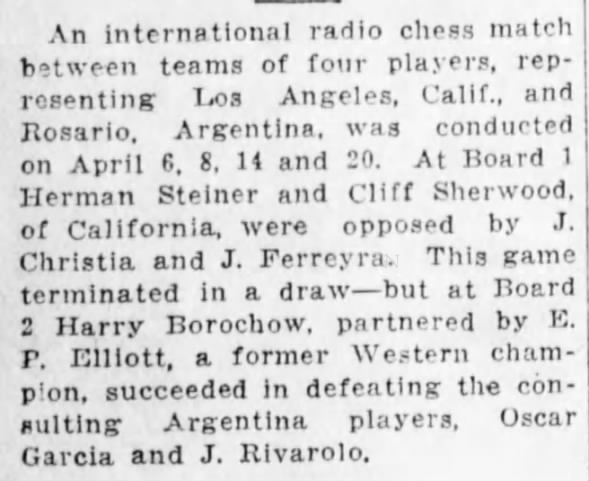 International Radio Chess Match 11 May 1930, Sun The Cincinnati Enquirer (Cincinnati, Ohio) Newspapers.com
International Radio Chess Match 11 May 1930, Sun The Cincinnati Enquirer (Cincinnati, Ohio) Newspapers.com
An international radio chess match between teams of four players, representing Los Angeles, Calif., and Rosario, Argentina, was conducted on April 6, 8, 14 and 20. At Board 1 Herman Steiner and Cliff Sherwood, of California, were opposed by J. Christia and J. Ferreyra. This game terminated in a draw—but at Board 2 Harry Borochow, partnered by E. P. Elliott, a former Western champion, succeeded in defeating the consulting Argentina players, Oscar Garcia and J. Rivarolo.
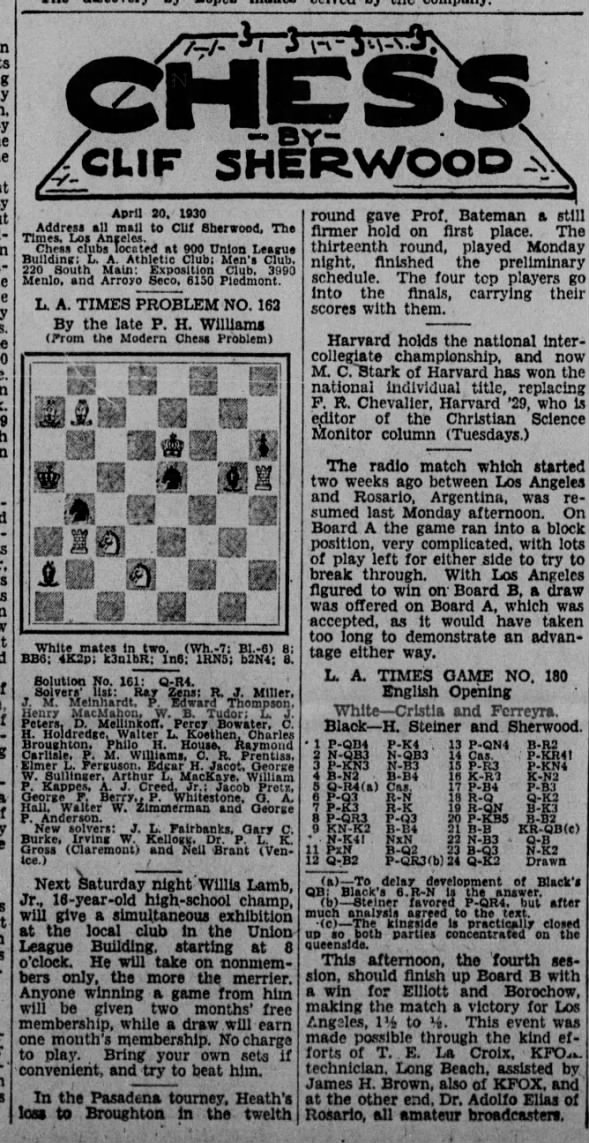 Chess by Clif Sherwood Sun, Apr 20, 1930 – 78 · The Los Angeles Times (Los Angeles, California) · Newspapers.com
Chess by Clif Sherwood Sun, Apr 20, 1930 – 78 · The Los Angeles Times (Los Angeles, California) · Newspapers.com
Chess by Clif Sherwood Sunday, April 20, 1930 The Los Angeles Times Los Angeles, California L.A. Times Problem No. 162...
Posted by Bobby Fischer's True History on Friday, November 20, 2020
L.A. Times Problem No. 162 by the late P.H. Williams. Fro the Modern Chess Problem. White mates in two.
FEN 8/BB6/4K2p/k3n1bR/1n6/1RN5/b2N4/8 w - - 0 1
Key: B-K3/Be3
If R-R3ch, BxK!!
1. Rh3 Nec6 2. Nc4#
The radio match which started two weeks ago between Los Angeles and Rosario, Argentina, was resumed last Monday afternoon. On Board A the game rank into a block position, very complicated, with lots of play left for either side to try to break through. With Los Angeles figured to win on Board B, a draw was offered on Board A, which was accepted, as it would have taken too long to demonstrate an advantage either way.
L.A. Times Game No. 180.Descriptive 1. P-QB4 P-K4 2. N-QB3 N-QB3 3. P-KN3 N-B3 4. B-N2 B-B4 5. Q-R4 O-O 6. P-Q3 R-N 7. P-K3 R-K 8. P-QR3 P-Q3 9. KN-K2 B-B4 10. N-K4! NxN 11. PxN B-Q2 12. Q-B2 P-QR3 13. P-QN4 B-R2 14. O-O P-KR4! 15. P-R3 P-KN4 16. K-R2 K-N2 17. P-B4 P-B3 18. R-Q Q-K2 19. R-QN B-K3 20. P-KB5 B-B2 21. B-B KR-QB 22. N-B3 Q-B 23. B-Q3 N-K2 24. Q-K2 Drawn |
Algebraic 1. c4 e5 2. Nc3 Nc6 3. g3 Nf6 4. Bg2 Bc5 5. Qa4(a) 0-0 6. d3 Rb8 7. e3 Re8 8. a3 d6 9. Ne2 Bf5 10. Ne4! Nxe4 11. dxe4 Bd7 12. Qc2 a6(b) 13. b4 Ba7 14. 0-0 h5! 15. h3 g5 16. Kh2 Kg7 17. f4 f6 18. Rd1 Qe7 19. Rb1 Be6 20. f5 Bf7 21. Bf1 Rc8(c) 22. Nc3 Qf8 23. Bd3 Ne7 24. Qe2 drawn 1/2 - 1/2 |
(a)—To delay development of Black's QB; Black's 6. R-N is the answer.
(b)—Steiner favored P-QR4, but after much analysis agreed to the text.
(c)—The kingside is practically closed up so both parties concentrated on the queenside.
This afternoon, the fourth session, should finished up Board B with a win for Elliot and Borochow, making the match a victory for Los Angeles, 1½ to ½. This event was made possible through the king efforts of T.E. La Croix, KFOX technician, Long Beach, assisted by James H. Brown, also of KFOX, and at the other end, Dr. Adolfo Elias of Rosario, all amateur broadcasters.
Game for Herman Steiner, not found listed as of 11/20/2020
< Prev Index Next >
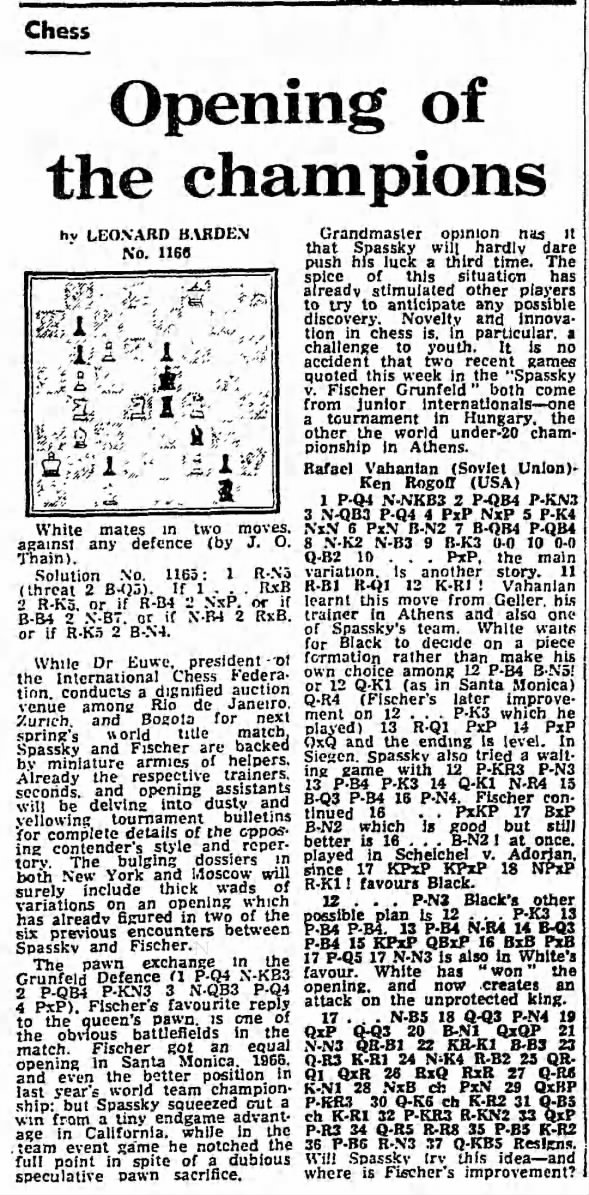 Chess Mon, Nov 22, 1971 – 19 · The Guardian (London, Greater London, England) · Newspapers.com
Chess Mon, Nov 22, 1971 – 19 · The Guardian (London, Greater London, England) · Newspapers.com
Chess: Opening of the Champions by Leonard Barden
While Dr. Euwe, president of the International Chess Federation conducts a dignified auction venues among Rio de Janeiro, Zurich and Bogota for next spring's world title match, Spassky and Fischer are backed by miniature armies of helpers. Already the respective trainers, seconds, and opening assistants will be delving into dusty and yellowing tournament bulletins for complete details of the opposing contender's style and repertory. The bulging dossiers in both New York and Moscow will surely include thick wads of variations on an opening which has already figured in two of the six previous encounters between Spassky and Fischer.
The pawn exchange in the Grunfeld Defence (1. P-Q4, N-KB3; 2. P-QB4 P-KN3; 3. N-QB3 P-Q4; 4. PxP). Fischer's favourite reply to the queen's pawn, is one of the obvious battlefields in the match. Fischer got an equal opening in Santa Monica, 1966, and even the better position in last year's world team championship; but Spassky squeezed out a win from a tiny endgame advantage in California, while in the team event game he notched the full point in spite of a dubious speculative pawn sacrifice.
Grandmaster opinion has it that Spassky will hardly dare push his luck a third time. The spice of this situation has already stimulated other players to try to anticipate any possible discovery. Novelty and innovation in chess is, in particular, a challenge to youth. It is no accident that two recent games quoted this week in the 'Spassky v. Fischer Grunfeld' both come from junior internationals—one a tournament in Hungary, the other the world under-20 championship in Athens.
< Prev Index Next >
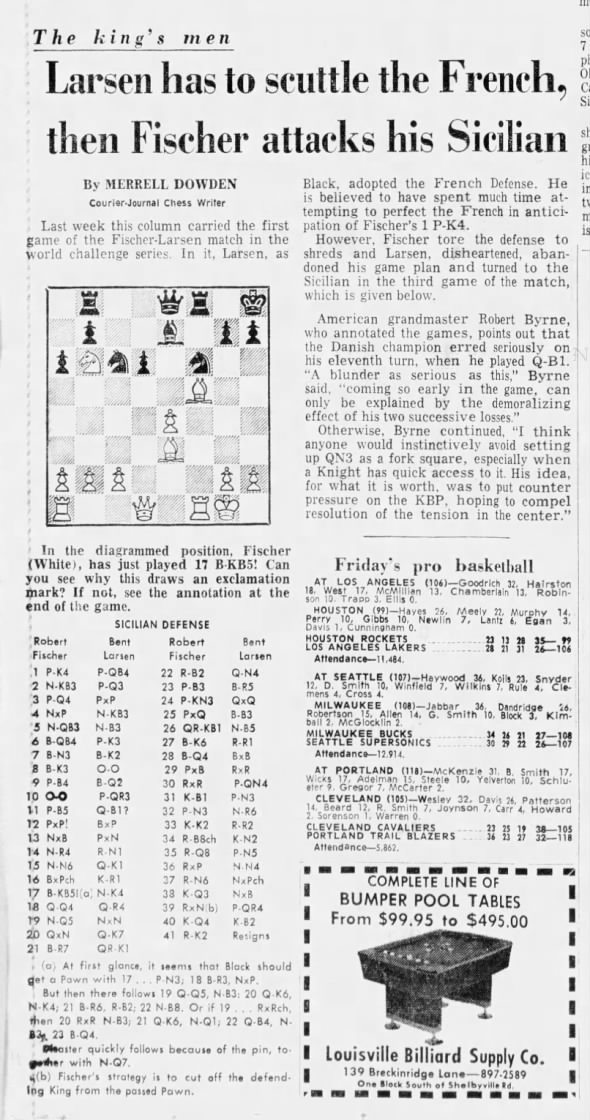 The King's Men Sun, Nov 21, 1971 – Page 57 · The Courier-Journal (Louisville, Kentucky) · Newspapers.com
The King's Men Sun, Nov 21, 1971 – Page 57 · The Courier-Journal (Louisville, Kentucky) · Newspapers.com
The King's Men: Larsen Has to Scuttle the French, then Fischer Attacks his Sicilian by Merrill Dowden
Last week this column carried the first game of the Fischer-Larsen match in the world challenge series. In it, Larsen as Black, adopted the French Defense. He is believed to have spent much time attempting to perfect the French in anticipation of Fischer's 1. P-K4.
However, Fischer tore the defense to shreds and Larsen, disheartened, abandoned his game plan and turned to the Sicilian in the third game of the match, which is given below.
American grandmaster Robert Byrne, who annotated the games, points out that the Danish champion erred seriously on his eleventh turn, when he played Q-B1. “A blunder as serious as this,” Byrne said, “coming so early in the game, can only be explained by the demoralizing effect of his two successive losses.”
Otherwise, Byrne continued, “I think anyone would instinctively avoid setting up QN3 as a fork square, especially when a Knight has a quick access to it. His idea, for what it is worth, was to put counter pressure on the K-BP, hoping to compel resolution of the tension in the center.”
'til the world understands why Robert J. Fischer criticised the U.S./British and Russian military industry imperial alliance and their own Israeli Apartheid. Sarah Wilkinson explains: Tweets by swilkinsonbc |
 “What a sad story Fischer was,” typed a racist, pro-imperialist colonial troll who supports mega-corporation entities over human rights, police state policies & white supremacy. |
To which I replied: “Really? I think he [Bob Fischer] stood up to the broken system of corruption and raised awareness! Whether on the Palestinian/Israel-British-U.S. Imperial Apartheid scam, the Bush wars of ‘7 countries in 5 years,’ illegally, unconstitutionally which constituted mass xenocide or his run in with police brutality in Pasadena, California-- right here in the U.S., police run rampant over the Constitution of the U.S., on oath they swore to uphold, but when Americans don't know the law, and the cops either don't know or worse, “don't care” -- then I think that's pretty darn “sad”. I think Mr. Fischer held out and fought the good fight, steadfast til the day he died, and may he Rest In Peace. Educate yourself about U.S./State Laws -- https://www.youtube.com/@AuditTheAudit/videos After which the troll posted a string of profanities, confirming there was never any genuine sentiment of “compassion” for Mr. Fischer, rather an intent to inflict further defamatory remarks. |
This ongoing work is a tribute to the life and accomplishments of Robert “Bobby” Fischer who passionately loved and studied chess history. May his life continue to inspire many other future generations of chess enthusiasts and kibitzers, alike.
The photograph of Bobby Fischer (above) from the March 02, 1956 The Tampa Times was discovered by Sharon Mooney (Bobby Fischer Newspaper Archive editor) on February 01, 2018 while gathering research materials for this ongoing newspaper archive project. Along with lost games now being translated into Algebraic notation and extractions from over two centuries of newspapers, it is but one of the many lost treasures to be found in the pages of old newspapers since our social media presence was first established November 11, 2017.
